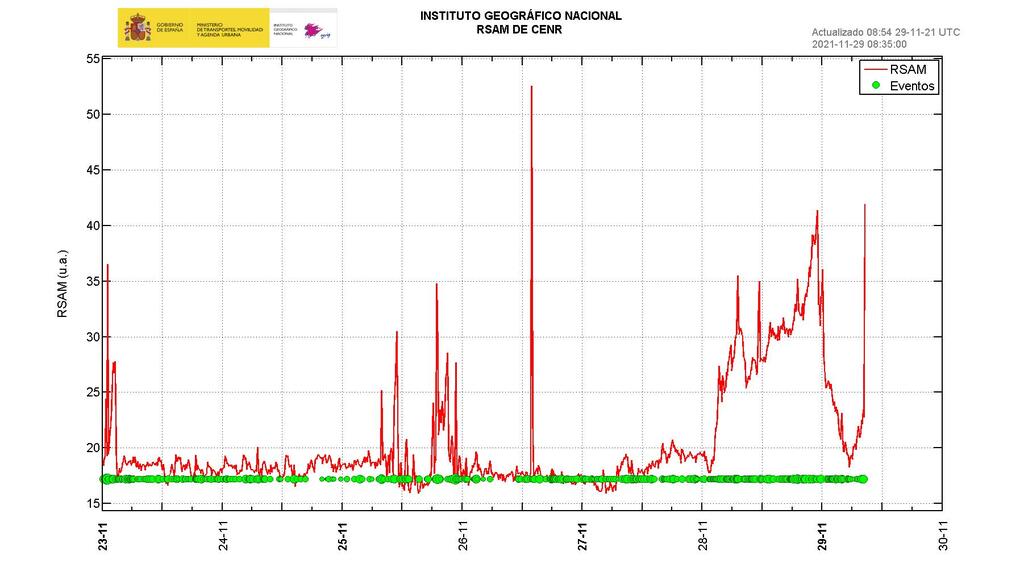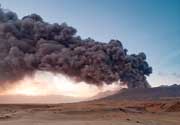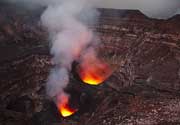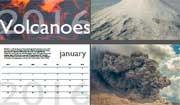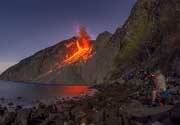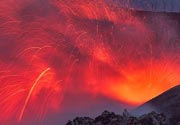Digital surface model of new cone
Update Tue 08 Feb 2022 00:57
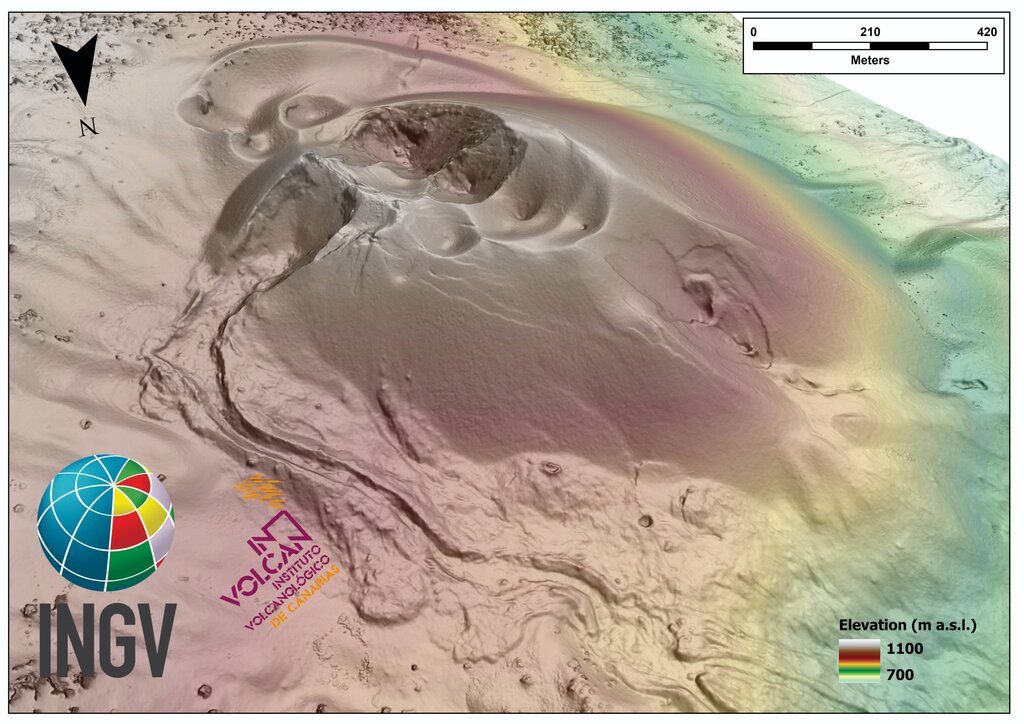
New DSM of the cone at La Palma volcano (image: INVOLCAN/INGV)

New DSM of the cone at La Palma volcano (image: INVOLCAN/INGV)
The volcanology institute INVOLCAN in collaboration with INGV Catania published a preliminary digital surface model (DSM) of the new cone as shown in the picture.
Digital Surface Model (DSM) is a commonly implemented geospatial feature generated with UAV mapping systems and captures both the natural and built/artificial features of the environment.
Eruptive episode ended after almost three months
Update Sat 25 Dec 2021 21:30

Degassing activity at La Palma volcano on 19 Dec (image: INVOLCAN/twitter)
The Instituto Geográfico Nacional (IGN) volcano observatory confirmed that
the activity at the volcano ended on 13 December at 22:21 local time.
The eruption that started on 19 September, lasted exactly 85 days and 8 hours.
The activity was dominated by strombolian activity and lava-fountaining episodes (paroxysm).
The low-level seismic activity continues including no signs of tremor signals although quakes are not ruled out.
The newly born basaltic scoria cone has reached 1,121 meters altitude with an estimated volume of about 200 million m3 of lava and tephra.
Volcano remains calm, but small quakes continue
Update Fri 17 Dec 2021 16:45
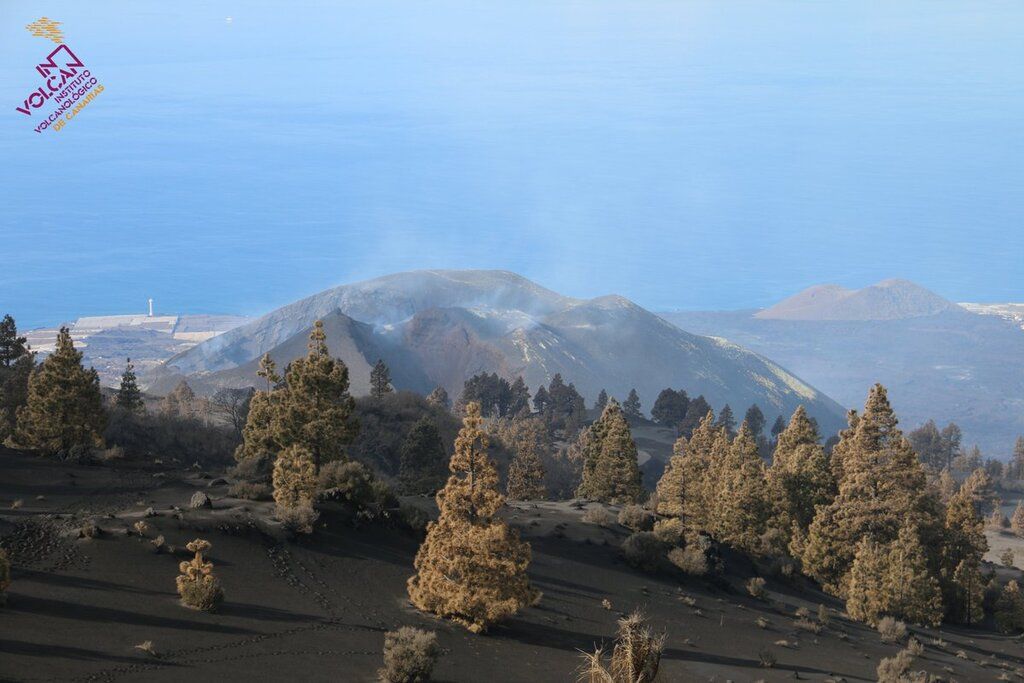
View of La Palma's new volcanic edifice from the Llano del Jable Astronomical Viewpoint at 11.00 am Canarian time (image: INVOLCAN / Twitter)

Depth vs time of quakes under La Palma showing an apparent increase of quake numbers, especially at depth

3D-View of quakes under the island since 14 Dec (image: info.igme.es)
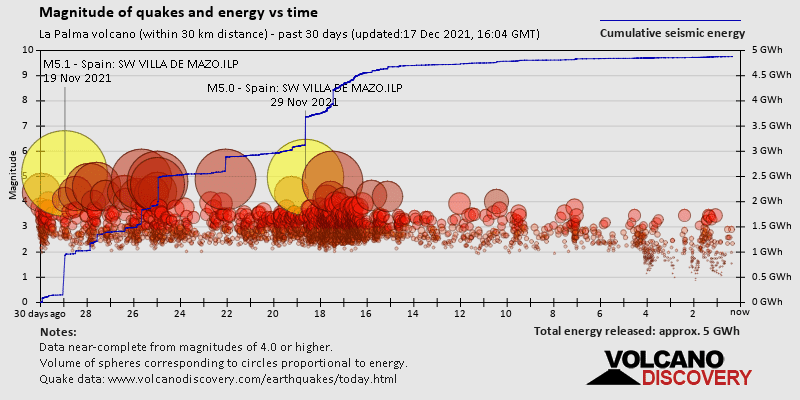
Quakes and combined seismic energy past 30 days
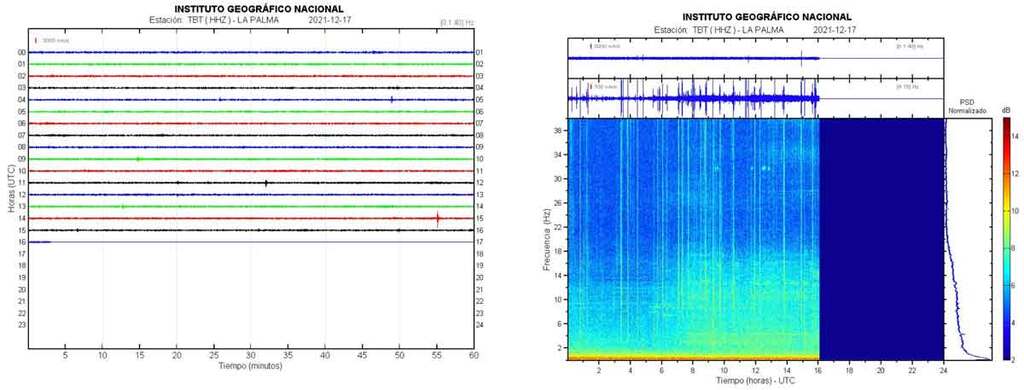
Current seismic signal at La Palma's TBT station - absence of tremor makes tiny quakes visible and detectable (image: IGN)
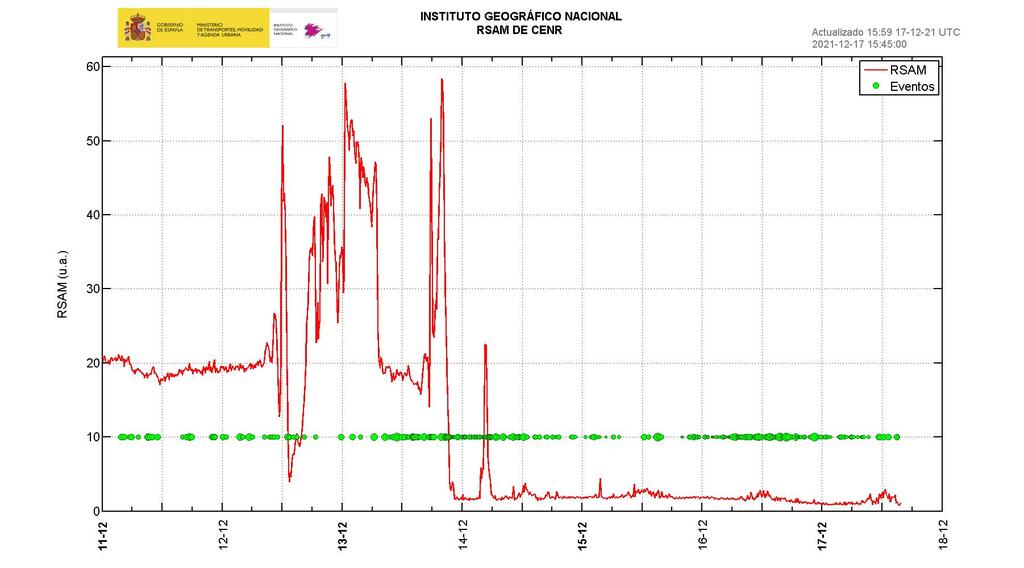
Current tremor amplitude - near zero (image: IGN)
For 3 days, no eruptive activity has taken place, and the likelihood that the eruption is actually over is clearly increasing. The cone only shows mild degassing and no lava flows are active any more.
Official confirmation when the eruption is declared over will likely need to wait a little longer. Some doubt remains as to the significance of the continuing earthquake activity: although of low energy and overall on a decreasing trend, it remains significant, and
could indicate that magma at depth is still able to pressurize and fracture rocks at depth and create intrusions that might eventually allow it to rise further. However, this is far from certain - it could also be adjustments of the system triggered by the massive shifts of masses that has occurred during the eruption. In the latter case, the quakes should slowly die out.
During the past 24 hours, there were 3 quakes of magnitudes 3.3-3.5 at 35-36 km depth, in addition to many more smaller quakes (22 quakes of magnitudes 2.0-2.9 and 48 quakes below magnitude 2.0). If looking at the various maps published of recent quakes, it might seem that there is a a strong increase of quakes. This apparent increase, however, is mostly in the
number of quakes, especially for those in the deeper region around 30-40 km. This is mostly an artifact caused by the absence of volcanic tremor, which acted as noise during the eruption and was simply hiding smaller quakes in its signal. Now, the very sensitive seismic devices are again able to pick up very small quakes below magnitudes 2, as well as quakes deeper down (whose signals at the surface are much weaker). In other words, most of the apparent increase of quakes is only an increase in detection sensitivity. Still, a weak increase in the total energy of the seismic activity remains visible for the past 48 hours or so. With most likelihood, it is part of a normal fluctuation, but nobody can be sure.
No new activity - pause of eruption or end?
Update Wed 15 Dec 2021 18:15
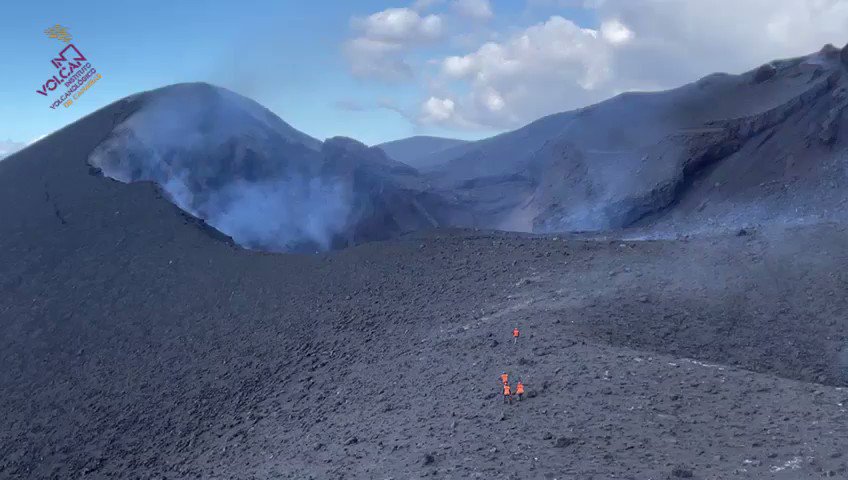
Scientists at the crater on La Palma today (image: INVOLCAN / Twitter)

Depth vs time of quakes under La Palma
No new activity has been reported at the eruption site since it ceased yesterday. Chances increase that the eruption is over, although this is far from certain (read below for more background).
The calm allowed scientists to actually approach the crater to take gas measurements and film the craters from close:
Is the eruption over?
Whether the eruption has ended or not will depend on whether magma still stored in the reservoir beneath the surface is able to ascend or not, which in turn is likely depending on two main factors:
First, whether the shallow reservoir is being re-supplied by magma from the deeper source, which should become visible with the occurrence of deeper earthquakes - lately, these have been mostly absent, suggesting that supply from the deep source has ended.
Second, the ascent of magma from the shallow reservoir is driven by gasses dissolved in the magma and forming bubbles to increase volume and pressure and eventually make the magma rise to erupt as lava.
If, and this is maybe a likely scenario, most of the gasses have already left the system or if the remaining gasses can separate efficiently from the liquid (magma), and rise and degas at the vents and through the surface, the magma will slowly start cooling down and eventually crystallize over a very long period of time.
It is also very much possible that the current pause of the eruption leads to a blockage of the upper conduits, which disables the degassing process and generates conditions that could lead to sudden explosions and allowing probably smaller batches of remaining magma to erupt in short phases of re-activation.
Nobody knows for now - the situation remains volatile and care should be taken to make any predictions of whether activity will resume or not.
La Palma volcano: activity drops sharply, eruption might have ended or is pausing
Tue, 14 Dec 2021, 15:11 15:11 PM | BY: T
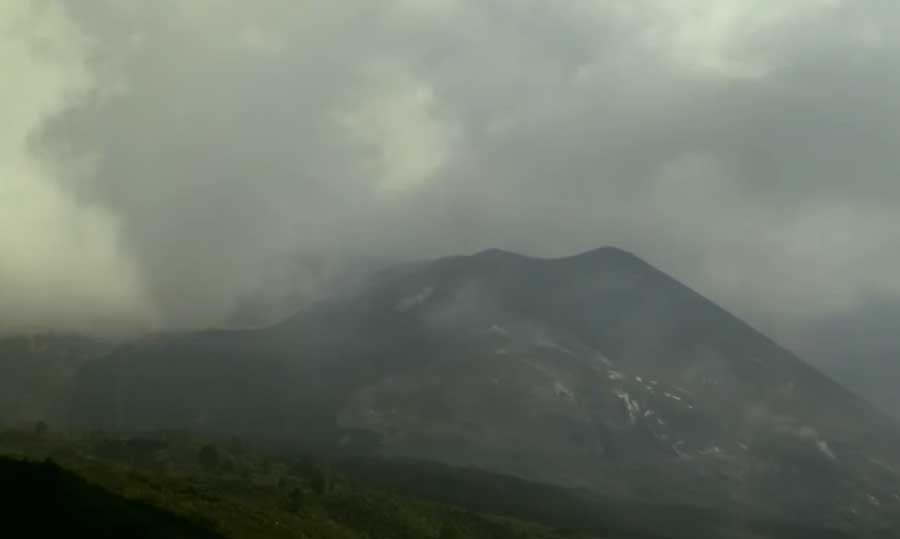
No activity seen at the cone on La Palma this afternoon (image: Canarias TV live stream)
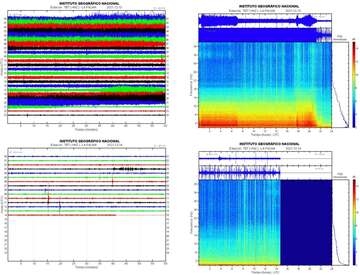
Seismic signal at TBT station (image: IGN)
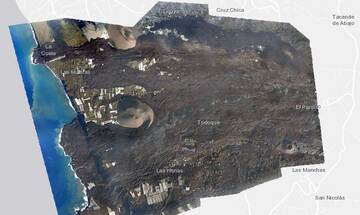
Aerial view of the area this morning (image: Government of La Palma/ opendatalapalma.es)
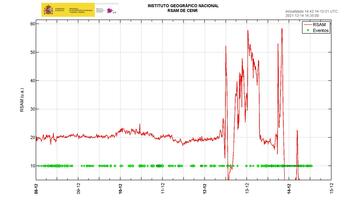
Current tremor amplitude past 7 days (image: IGN)
The eruption might have stopped or is pausing today, which is day #87 since it started on Sep 19, 2021.
After a temporary strong increase yesterday producing lava fountaining and tall ash plumes, visible activity decreased drastically and more or less ceased today. No significant explosions or lava flows can be seen on any of the available images from the vents or on this morning's drone surveillance flight. Volcanic tremor has dropped to its lowest levels since the eruption began, and is close to absent now.
The absence of tremor in the signal in turn allows to detect tiny quakes of magnitudes below 2, which leads to an increase in the number of total detected quakes - IGN reported 129 events, but only 5 of them were at least of magnitude 3 and none above 3.2, which is among the lowest-by-energy combined values counts since the beginning of the eruption.
Whether or not the eruption is now already at its end is hard to say, but it is most likely at least close to it.
La Palma volcano eruption update: eruption intensifies intermittently
Mon, 13 Dec 2021, 23:10 23:10 PM | BY: T
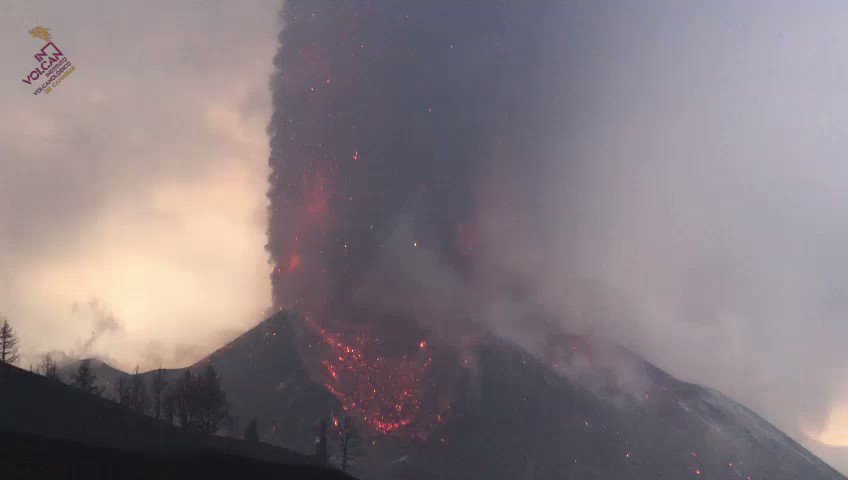
Lava fountaining and ash emissions this afternoon (image: INVOLCAN / Twitter)
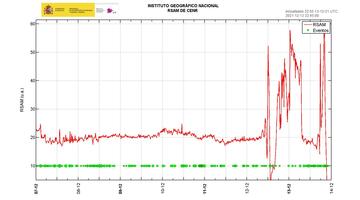
Current tremor amplitude past 7 days (image: IGN)
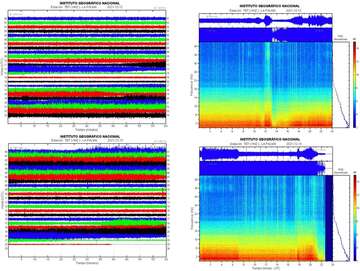
Seismic signal TBT station since yesterday (image: IGN)
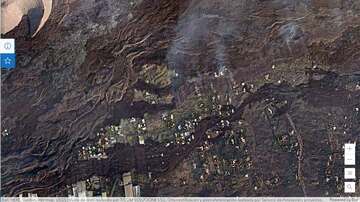
Aerial view of active lava flows in the area south of Todoque this morning (image: La Palma government / opendatalapalma.es)
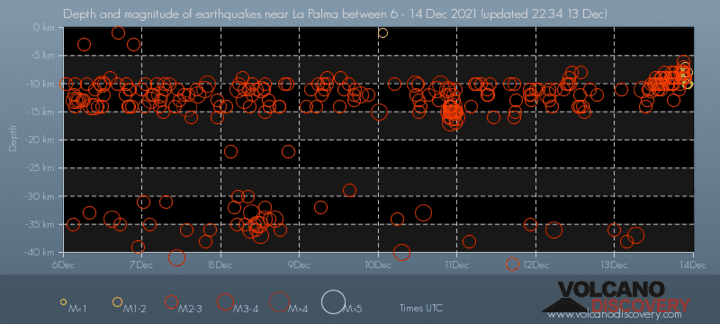
Time vs depth of quakes under La Palma during the past days
After yesterday's large explosion at noon, the eruption gained in intensity, both explosive and effusive, during the evening and night. After being quieter most of the day today, it increased again in the evening, shown by the strongly fluctuating volcanic tremor signal.
Phases of strong ash emissions and lava fountains have been alternating with quiet periods when only steaming could be seen at the craters:
Ash plumes reached 4,200 m above sea level this morning, and reportedly up to 7,000 m in the afternoon, and drifted southeast. Absence of wind near the ground created very high SO2 concentrations in El Paso today, with values surpassing 2.590 micrograms per cubic meter this morning.
Lava continues to flow from the (hidden) vents on the western base of the cone into the tube system and crate breakouts in the central part of the flow field. One of the more active surface flows began to eat away one of the remaining islands of so-far untouched land in the area south of Todoque and east of Las Norias, as can be seen in the aerial drone image attached.
The number of quakes has again increased in numbers: During the past 24 hours, there have been 4 quakes of magnitudes 3.0-3.4 and 46 quakes between 2.0 and 2.9. Most of these occurred at the shallow layer around 10-15 km depth while only very few ones occurred at the deeper layer of 30 km or below.
The decrease of seismic activity in the deeper layer might indicate that magma supply from that area is less now than during previous weeks when lots of magnitude 4+ quakes occurred there, but this remains speculative.
No significant changes in deformation has been recorded.
Sudden large explosion today sends ash to 5,000 m altitude
Update Sun 12 Dec 2021 17:21
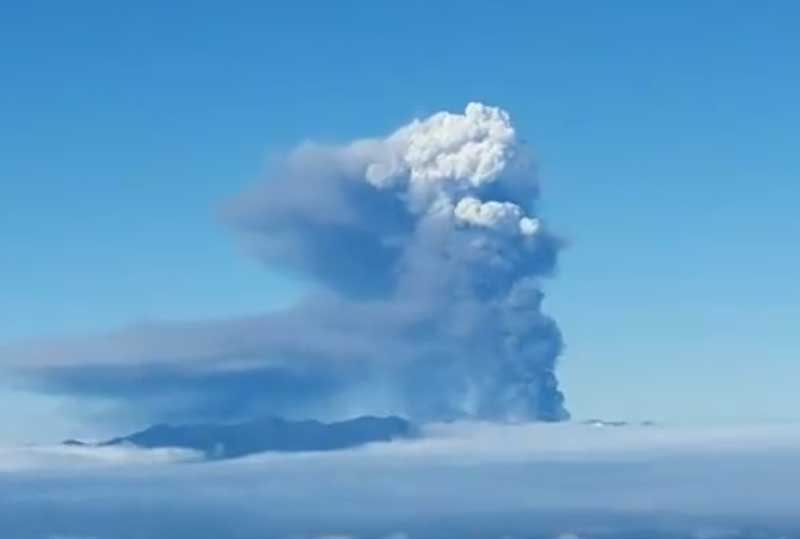
Eruption plume from today's vulcanian-type explosion at La Palma (image GEVolcan / facebook)
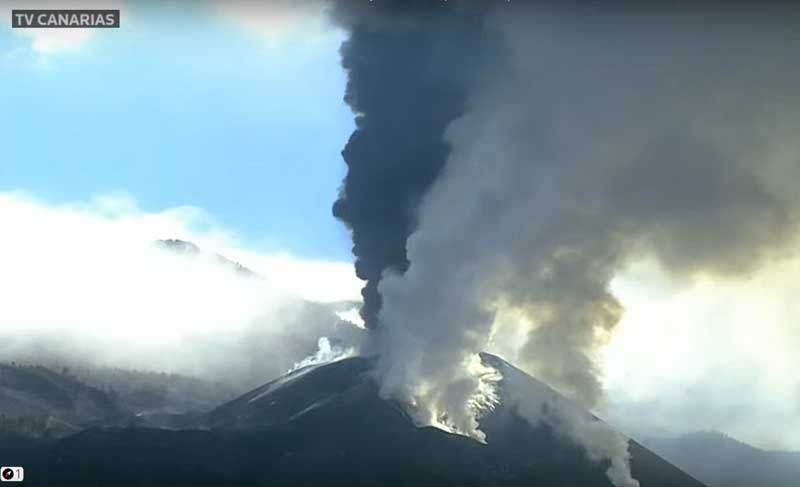
Ash column at the vent seen on the Canarias TV live stream
Around noon local time, a sudden large explosion occurred at the main crater of the cone, producing a steam and ash plume that quickly rose to estimated 5,000-6,000 meters altitude.
The event was likely a so-called vulcanian explosion, typically caused when a larger plug in the upper conduit has formed and is suddenly thrown out when gas pressure underneath overcomes a threshold (comparable to a cannon-shot mechanism).
Today's explosion likely might be due to the fact that the conduits have gradually been closing up / filling with debris in their upper parts as supply of rising material is less abundant. This fits with the model that the eruption has entered its final waning stage, but also creates highly dangerous conditions, because such explosions could (and likely will) repeat in the days to come.
Apart from this, the eruption - now on its 85th day of activity being the longest in recorded history on La Palma Island - has continued at low levels similar as in the past days. There is now mainly steaming, with only occasional smaller explosions, at the main cone, while lava effusion continues at reduced rate. The arriving lava first goes into the tube system, and feeding flows in similar areas as during the past days overlapping older flows.
Seismic activity has been low, with only 24 quakes detected during 24 horus, the maximum being only a 3.2 event. Deformation and tremor remain basically unchanged at low values, although the explosion earlier resulted in a short-lived intense tremor peak.
Eruption continues, but at gradually decreasing intensity
Update Sat 11 Dec 2021 15:59

Lava flows this morning at Las Hoyas (image: INVOLCAN)
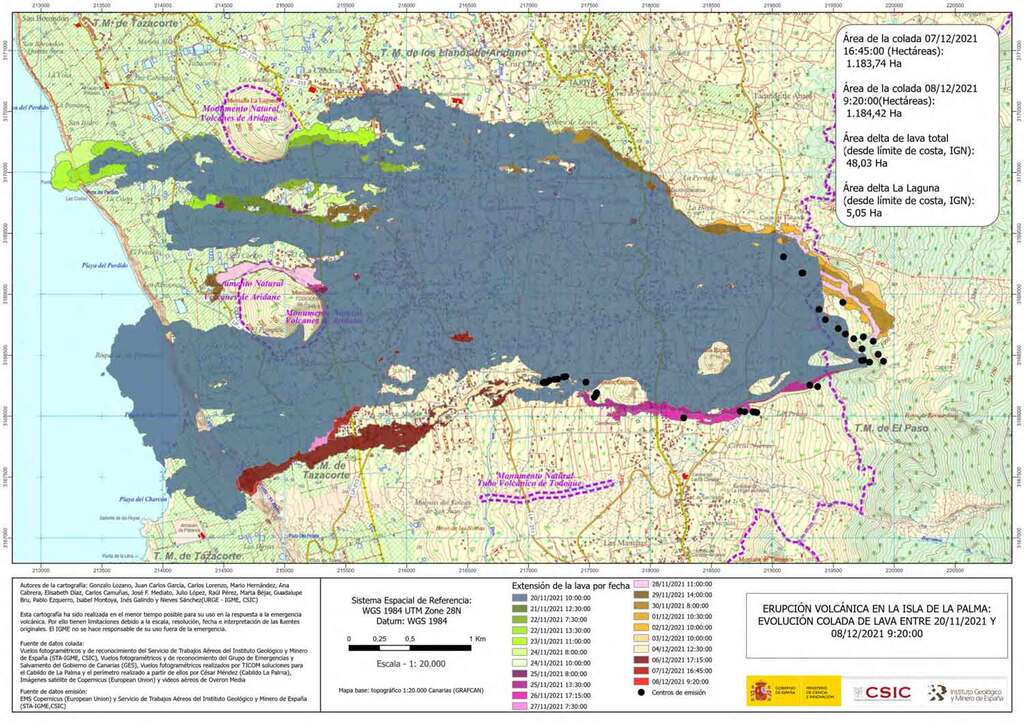
Latest map of the lava flows as of 8 Dec (image: info.igme.es)

SO2 measurements showing a small increase today (image: IGME)
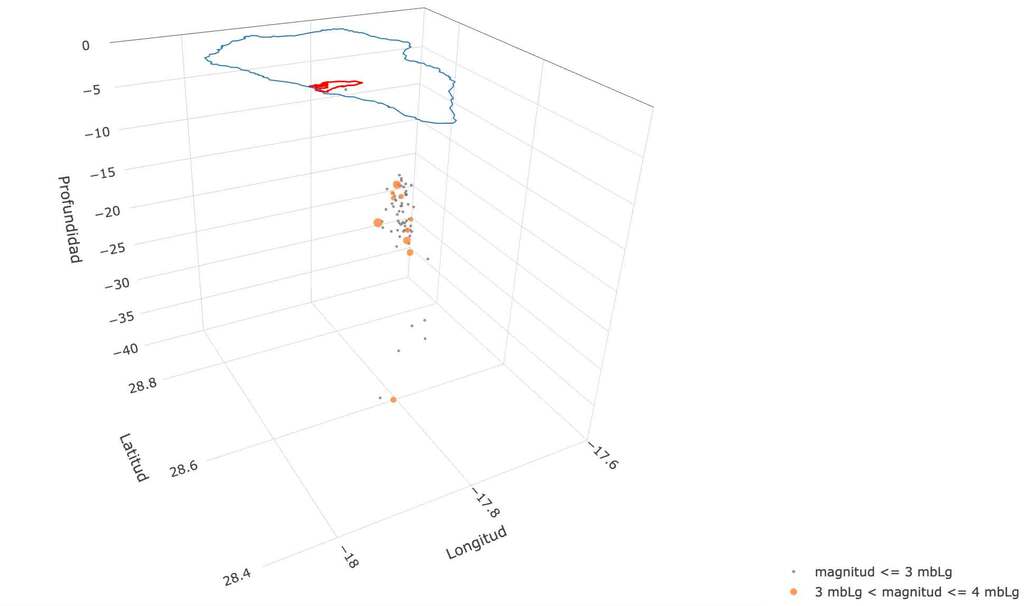
Quakes under La Palma in 3D during 9-11 Dec 2021 (image: IGME)
No significant changes have occurred since the last updates. The eruption continues, but more and more it looks as if it might finally be getting close to an end within a foreseeable future, but it can only be guessed what how long exactly it still might last, maybe few weeks.
At the vents, steaming is prevalent, with occasional small explosions of strombolian type and ash emissions that occasionally produce plumes that rise a few hundred meters. Effusive activity remains more or less stable, however. Lava continues to erupt, mainly directly into lava tubes, and breaks out to form surface flows downslope in the central part of the lava flow field.
As of today, there were two flows seen active, traveling westwards over existing lava flows. No (or at least no significant amounts of) new land was covered by new flows recently and no lava is arriving at the shore, but the westernmost flow continues to fall over the cliff towards the fore-land at La Hoyas:
The latest
detailed map of the areas covered by lava flows is from Dec 8, but has not changed much as of today.
Volcanic tremor continues to slowly decrease, suggesting that magma supply is fading. Earthquakes and gas emissions showed a small uptick during the latest 24 hours.
The National Geographic Institute recorded 44 quakes in total during its latest 24-hour reporting interval, the largest being a magnitude 3.7 quake last night at 9.27 p.m. local time, felt by some residents.
Ground deformation is showing a slow trend of deformation, consistent with depletion of magma inside the deeper and shallow reservoirs.
La Palma volcano eruption update: eruption continues at low levels, slowly declining intensity
Thu, 9 Dec 2021, 17:19 17:19 PM | BY: T
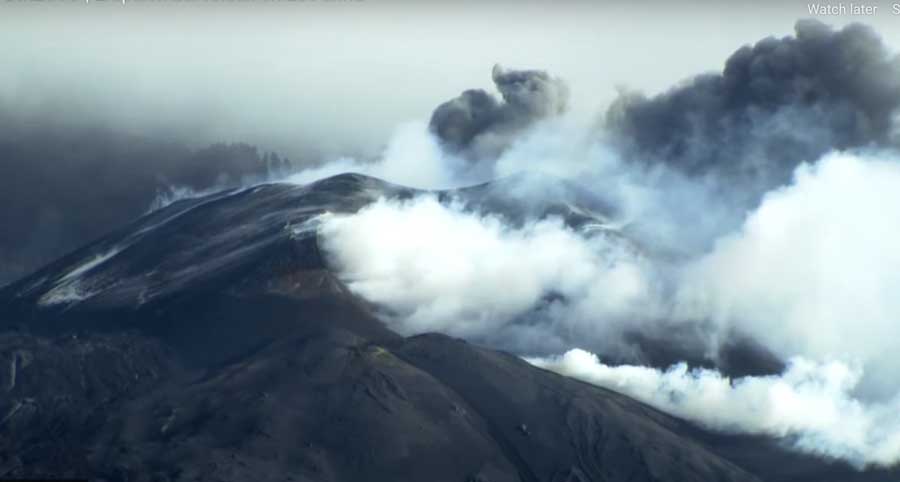
Ash emissions at the vent of La Palma this afternoon (image: Canarias TV live stream)
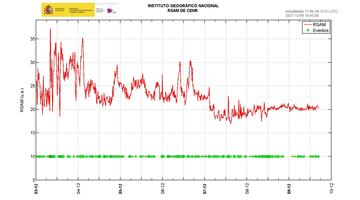
Current tremor amplitude past 7 days (image: IGN)
The eruption continues along a very slowly decreasing path. Activity today has been more or less as yesterday, but a bit weaker at the vents.
Only sporadic explosive activity occurred, occasionally producing ash plumes that rose a few hundred meters.
Volcanic tremor remains low at similar amplitude as in the past days, but with less and less fluctuations. Lava continues to effuse into the tube system beginning at or near the cone, and is mainly feeding the same flow as in the past days, which emerges onto the surface in the central part and branches off mainly towards the southwest. No significant enlargement of the lava flow field has occurred in the past days.
Other parameters also show a decreasing trend at the moment, including gas emissions, ground deformation and seismic activity. The National Geographic Institute (IGN) reported 32 earthquakes during its latest 24-hour reporting interval. The strongest one was a magnitude 3.6 event at 12:09 UTC at a depth of 37 km.
La Palma volcano eruption update: lava flows continue to advance towards the sea in the Las Hoyas area
Wed, 8 Dec 2021, 17:56 17:56 PM | BY: T
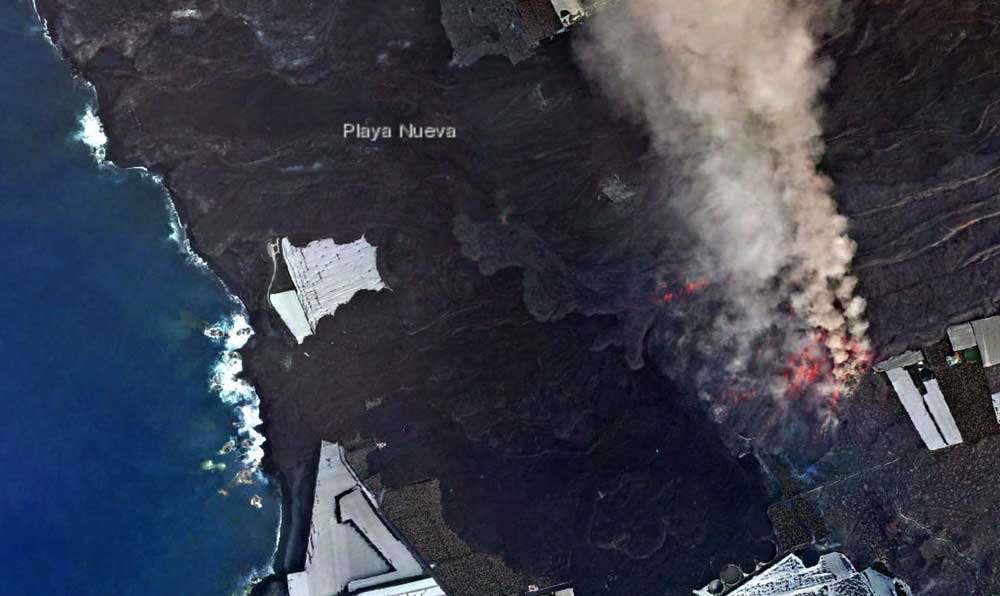
Lava flows descending the cliff onto the coastal flat at Las Hoyas (image: Government of La Palma/ opendatalapalma.es)
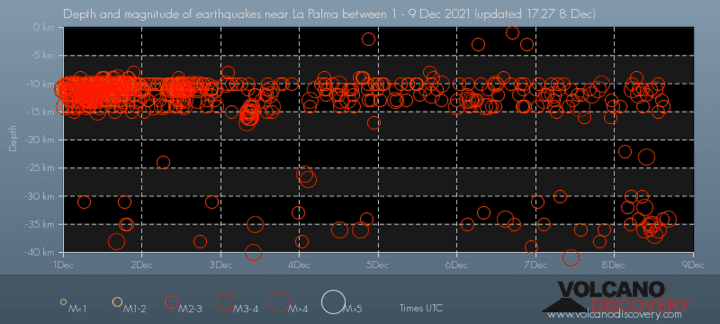
Time vs depth of quakes under La Palma during the past days
The eruption continues more or less in the same way as yesterday - intermittent strombolian-type explosions and sometimes stronger ash emissions occur at the main vents of the cone. Ash plumes have reached altitudes around 3,700 m and drifted towards southerly and southeasterly directions.
Lava effusion remains stable, concentrated from vents near (or beneath) the cone, where they enter tubes, to break out as surface flows further downslope, mainly in the central part of the flow field, where lava flows continued to initially travel through a narrow and the widening channel, before spreading into various arms. One of them is now covering the lava flows that had erupted from the fissure vents west of Montaña Cogote. The latter have practically ceased to be active.
Active lava flows have continued to descend the steep cliff onto the the coastal flat of Las Hoyas, but without reaching the sea itself. Thick smoke was rising from burning plantations in the area this morning.
An increase in sulphur dioxide (SO2) emissions was reported today. Earthquakes have picked up a bit as well, especially in the deeper layer of 30-40 km depth. During the past 24 hours, there were 13 quakes of magnitude 3.0-3.6 and 27 quakes between 2.0 and 2.9.
Volcanic tremor remains low, at similar values as yesterday. No significant deformation has been recorded.
The following video by IGN shows the ground cracks on the flank of Montaña Cogote associated with the lavas that had erupted there last week (but now ceased):
Update Wed 08 Dec 2021 17:44
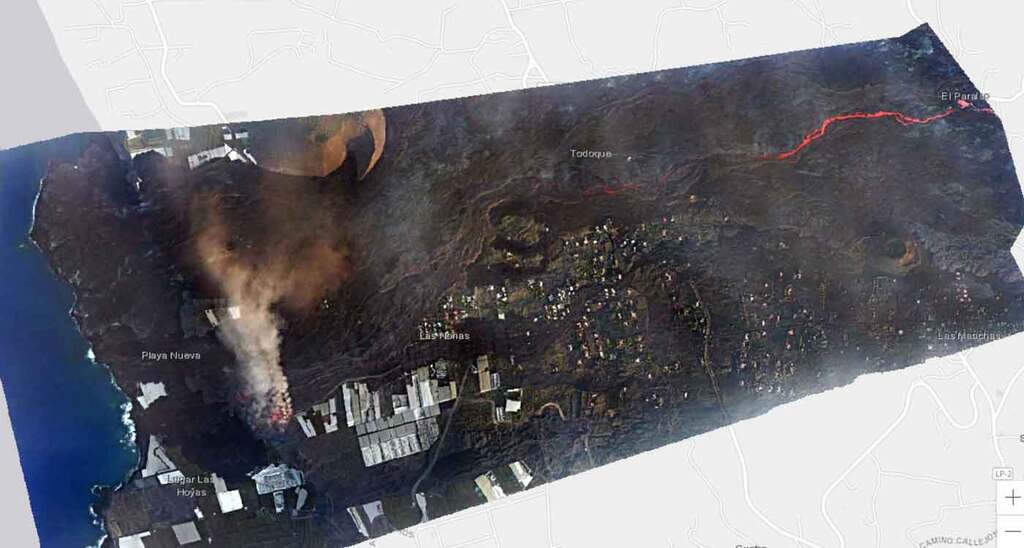
Aerial view of lava flow this morning (image: La Palma government / opendatalapalma.es)
Latest map of lava flows
Update Wed 08 Dec 2021 17:41
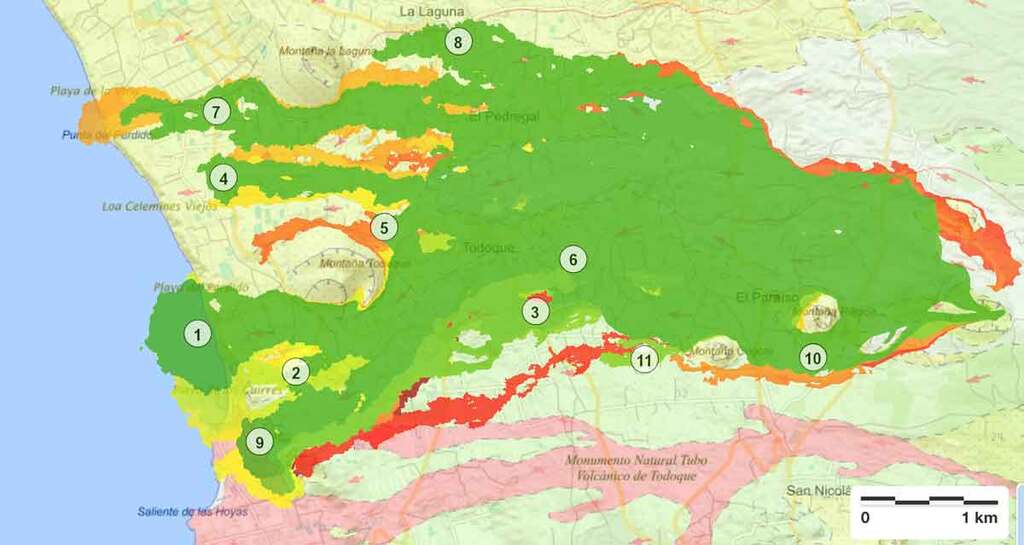
Latest map of the lava flows (image: info.igme.es)
Update Wed 08 Dec 2021 17:14
A new aerial drone video was taken today by the El Paso municipality, showing the areas (partially) covered by lava flows as well as thick ash deposits from upper Todoque (Las Norias) until San Nicolás in Las Machas neighborhood:
Eruption continues with little changes
Update Tue 07 Dec 2021 21:54
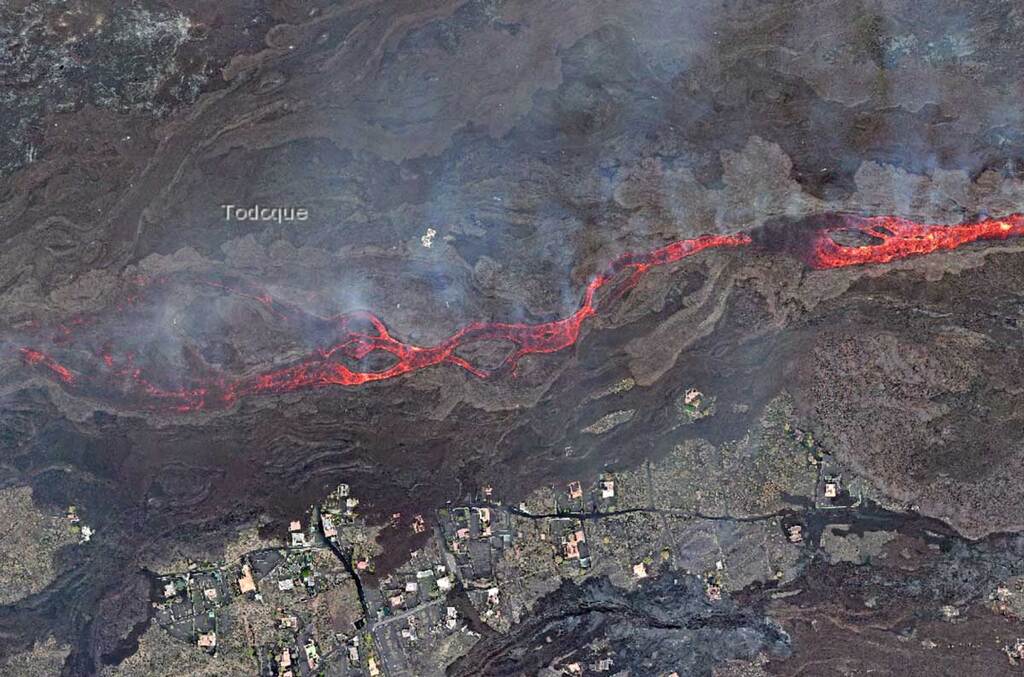
Active lava flows this morning in the area of Todoque (image: Government La Palma via opendatalapalma.es)
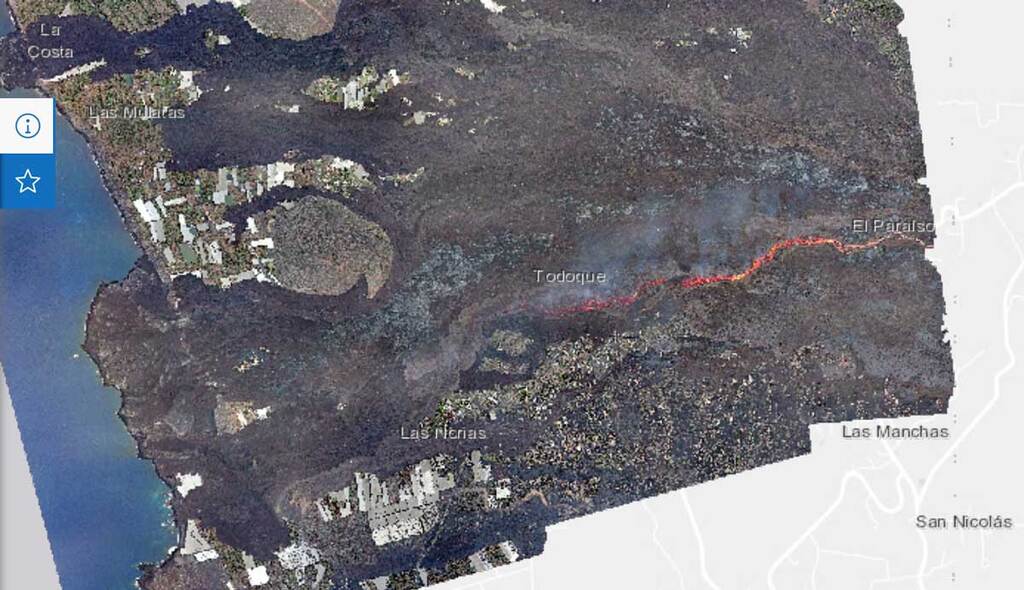
This morning's drone image of the area (opendatalapalma.es)
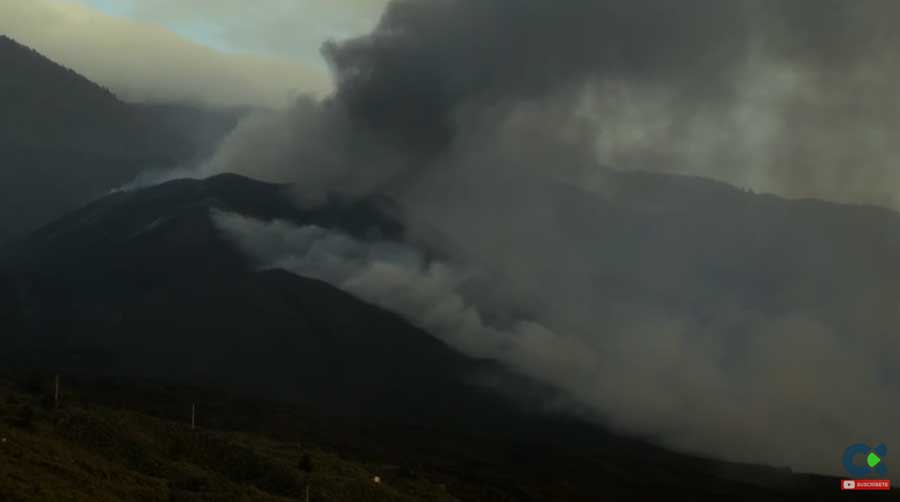
The vents this afternoon (image: Canarias TV live stream)
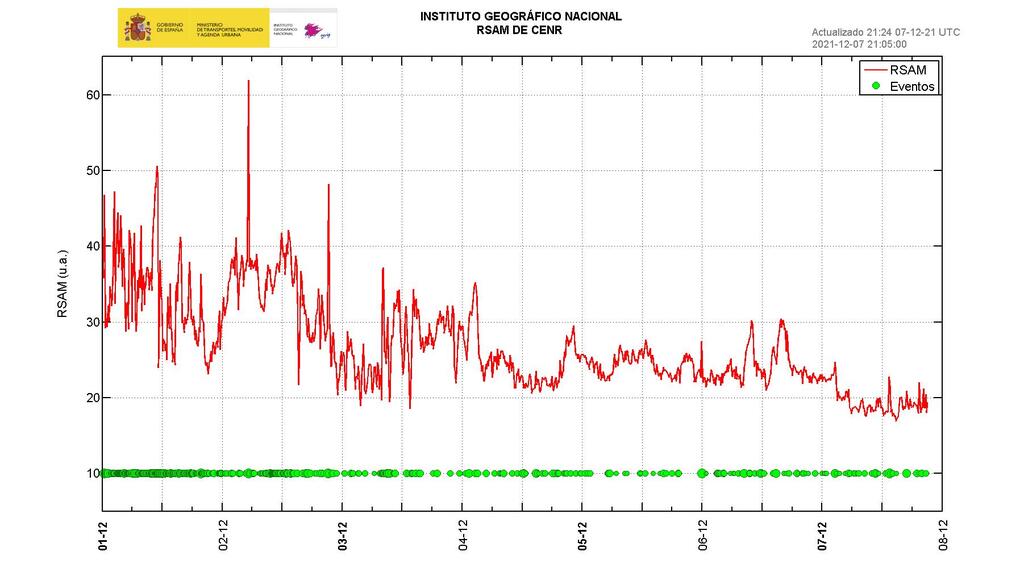
Volcanic tremor amplitude past 7 days (image: IGN)
The eruption continues at similar, generally low intensity as yesterday, with a slight uptick in ash emissions that reached again up to 3,000 m altitude and drifted northeast. No significant change has taken place at the vents of the cone, which are mostly steaming and having intermittent strombolian-type small explosions.
Lava effusion continues also without significant changes. Most lava is coming from vents west of the main cone and directly entering the tube system. Some of it breaks out to form a prominent channeled surface flow in the central part of the lava flow field, which is branching off in the area of Todoque and changes direction towards the southwest from there, along the flow labeled #11 and joining with flow #9 to feed the first and largest lava delta (although no lava seems to be actively reaching the sea shore). On its way, it continued to eat away at left-over islands of land so far not touched by lava flows.
The lava flow from the new vent system west of the Cogote Mountain remains active as well. It, too, is mostly inside a tube on the first section of its path, then emerges to form surface flows that spill over the cliff in the Las Hoyas area and spills onto the lower coastal flat land.
The area covered by lava flows has increased by 27 hectares during 36 hours and now is estimated to be 1,182 hectares, with a maximum width of 3,350 meters. The new lava deltas combined are about 48 hectares in size.
Damage to infrastructure since the beginning of the eruptive process, according to information provided by the Copernicus satellite, amounts to approximately 3,039 buildings, of which 2,881 are be completely destroyed and 158 damaged.
No significant changes in ground deformation occurred. Volcanic tremor and seismic activity have been low. During the latest 24 hours, there were 1 quake of magnitude 4.0, 6 quakes between 3.0 and 3.9, and 26 quakes between 2.0 and 2.9 under the volcano.
It looks as if finally, the eruption might be in the stage of dying down slowly although nobody can predict a precise time frame how long it may still last. A new burst of more intense activity if also still possible any time.
Update Tue 07 Dec 2021 21:22
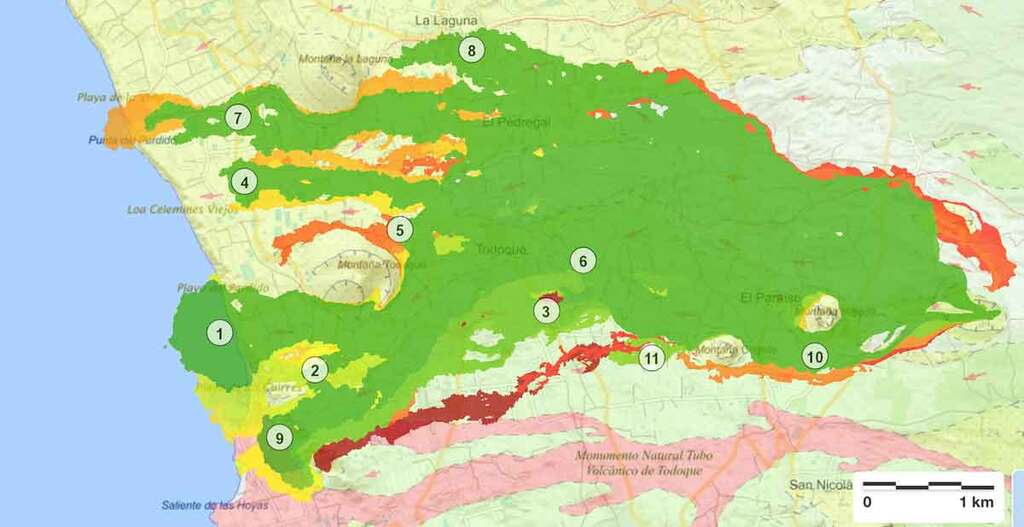
Latest map of the lava flows (image: info.igme.es)
Lava continues to flow, while eruption intensity gradually decreases
Update Mon 06 Dec 2021 19:06
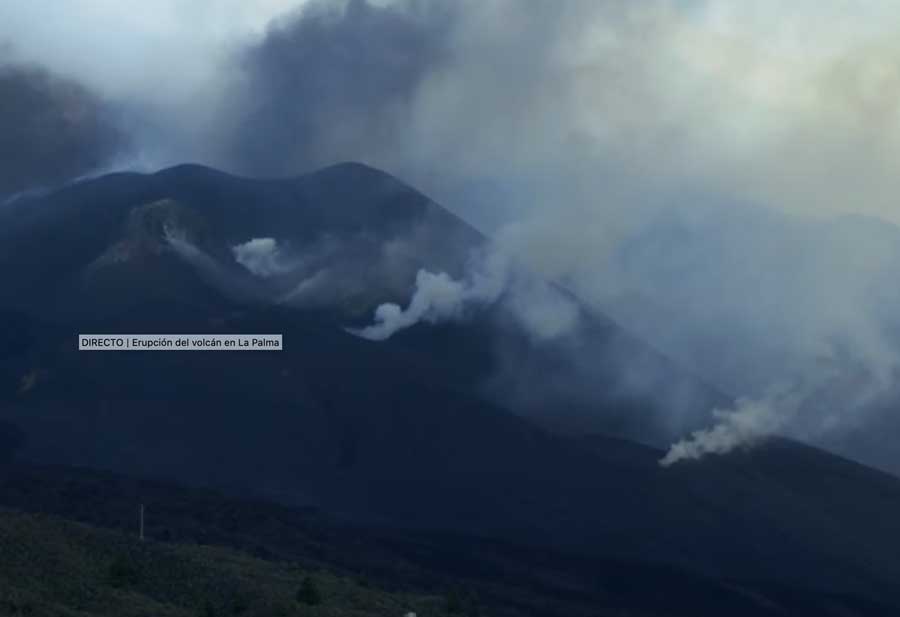
Situation at the vent of La Palma this afternoon (image: Canarias TV live stream)
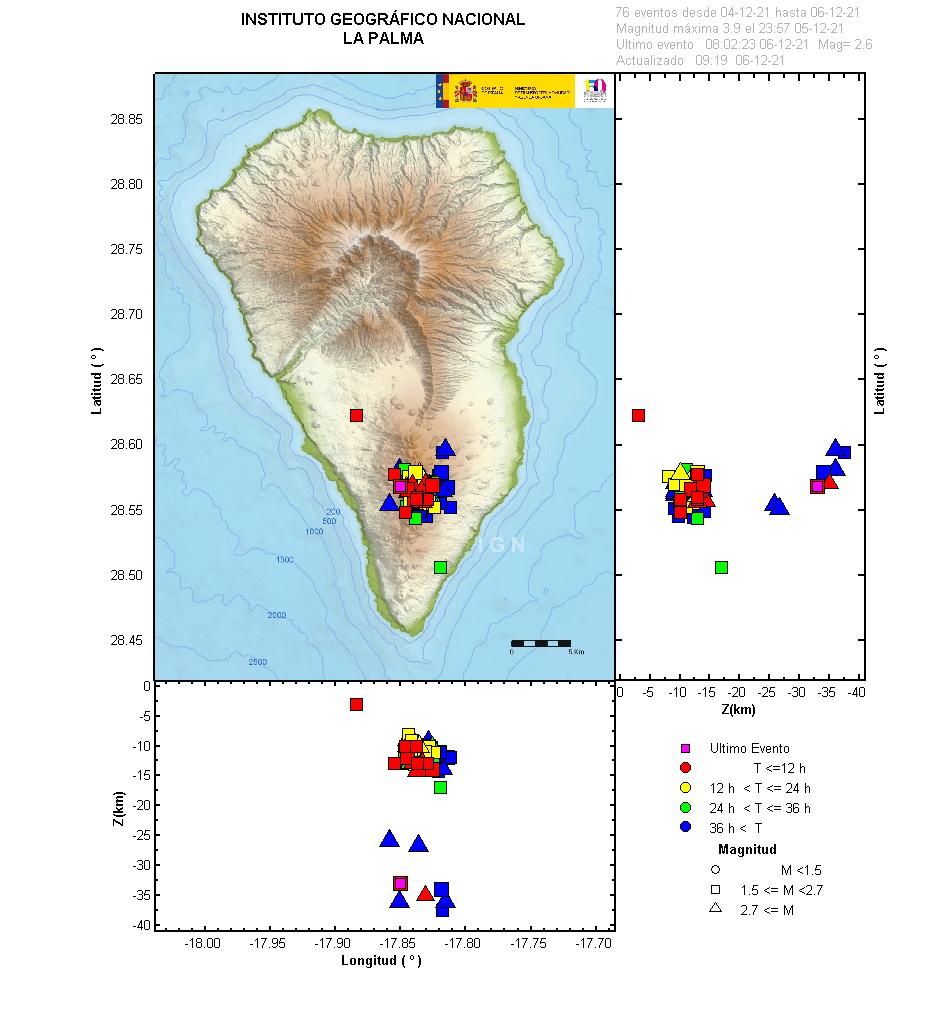
Recent quakes under La Palma during the past 3 days (image: IGN)
Activity has been similar as yesterday and overall continued to decline. At the vent, ash emissions and explosions have been rare and intermittent, but produce occasional plumes rising up to approx 2,000 m altitude.
Lava effusion continues at similar levels as yesterday, but seems to be now again mainly coming from the vents at the main cone, while the new fissure that opened last week at the southern margin of the flow field west of Montaña Cogote is less active and has merged with the southernmost older flow. Its front has merged with the flow number #9 in the flat lava delta that had formed in the 1949 eruption, but has so far not entered the ocean.
Volcanic tremor remains similar as yesterday at low levels without much fluctuations.
Seismic activity has continued to decrease. Only about 20 quakes were registered during a 24 hour period, likely the lowest number since the beginning of the eruption.
No significant change has been seen in other monitored parameters (deformation, gas emissions).
An interesting drone video shows the vent and lava flow configuration nicely, taken on 4 Dec:
The following drone video taken by IGN takes you on a breathtaking flight along and partially even inside the main surface lava channel that starts at the western base of the cone and has been feeding the central part of the lava flow field with various active branches during the past days and weeks:
La Palma volcano eruption update: lava flow from yesterday's new fissure advances over new land towards the sea
Sun, 5 Dec 2021, 17:16 17:16 PM | BY: T
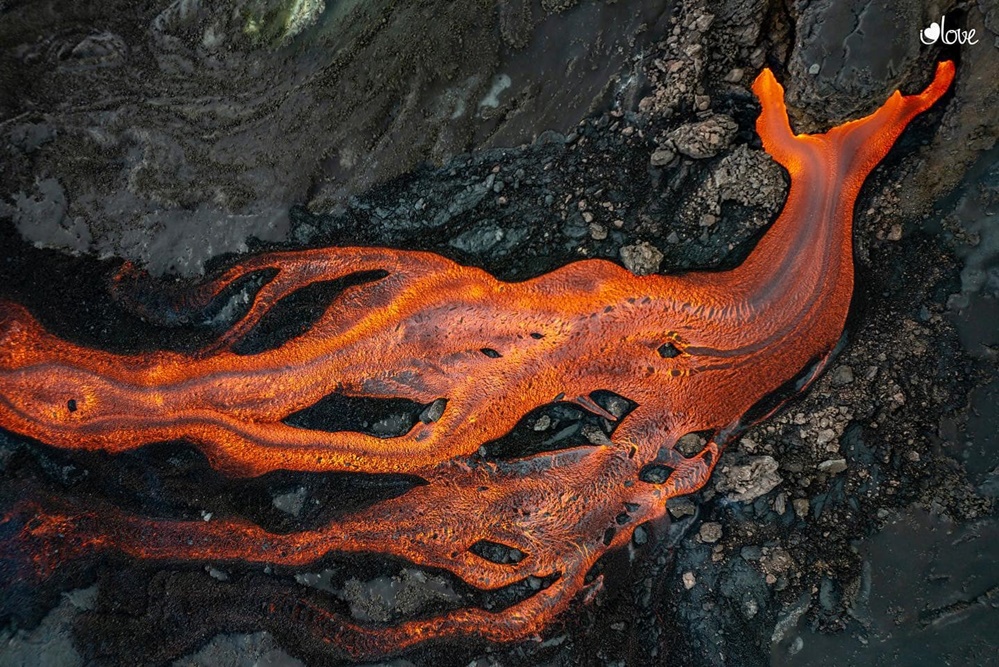
Aerial view of the lava flows on La Palma today or yesterday (image: El Time)
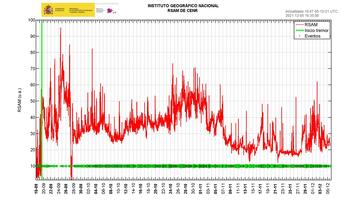
Volcanic tremor amplitude since start of eruption (image: IGN)
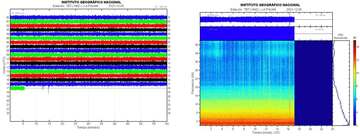
Current seismic signal TBT station (image: IGN)
Visible activity at the vents has been mostly low today. Most of the time, only steaming could be seen from the craters and only intermittent, weak pulses of strombolian activity and ash emissions only reaching a few hundred meters height. However, lava continues to flow from both the old vent areas (going mostly into the lava tube system) and the new fissure vents that had opened yesterday at 12.45 p.m. in an area 500 m west of Montaña Cogote south of Todoque, in the middle of a populated (but long-since evacuated) area.
The new lava flow from this fissure traveled westwards along the southern margin of the existing flow field, covering new land and destroying additional buildings. Today, it continued to advance towards the coast and was near cliff in the Las Hoyas area this afternoon, but has not yet reached it.
The latest count of destroyed buildings rose to 2790 and the area now covered by lava flows increased by 9 hectares to now 1,155 hectares (1.55 square kilometers).
Seismic activity has been decreasing further. During the latest 24-hour reporting interval, the National Geographic Institute (IGN) detected only 35 quakes under the island, none of which was felt by the population at a wider scale. The quakes occurred under the central area of Cumbre Vieja in the same areas as during the whole time of the eruption.
33 of these earthquakes were located at depths of 9-17 km and only 3 at depths greater than 34 km. The amplitude of the volcanic tremor signal remains low and more stable than in previous days.
Ground deformation: The island's network of permanent monitoring stations shows a complete reversal of the elevation recorded on December 2 at station LP03, which is the closest to the eruptive vents. At the other stations, slight deflation possibly related to deep seismicity has stabilized.
Gas emissions:Emission of sulfur dioxide (SO2) remains high, implying that there is still a log of magma available to erupt, although it has been on a decreasing trend. In the case of diffuse carbon dioxide (CO2) emissions, values have been stable, but still well above background levels or 5.3 times higher according to the latest scientific data.
Picture source: Se confirma la nueva fisura y la destrucción de un "amplio" número de viviendas (El Time)
Latest map of lava flows
Update Sun 05 Dec 2021 17:01

Latest map of active lava flows at La Palma (image: La Palma government)
During this evening's press conference, the latest map was published showing the current state of lava flows including the new ones from the past days and the fissure that opened yesterday shortly after noon.
New fissure opens
Update Sun 05 Dec 2021 15:48
A new fissure opened earlier today at 12.45 p.m. local time 500 m west of the Montaña Cogote cinder cone, in the middle of areas with houses and gardens. A new lava flow from this fissure destroyed an unkown number of additional buildings. Updates will follow.
Update Sun 05 Dec 2021 15:42
Latest maps of the lava flows as of today (5 Dec, 2021):
La Palma volcano eruption update: activity slows down overall, at least temporarily
Sat, 4 Dec 2021, 19:38 19:38 PM | BY: T
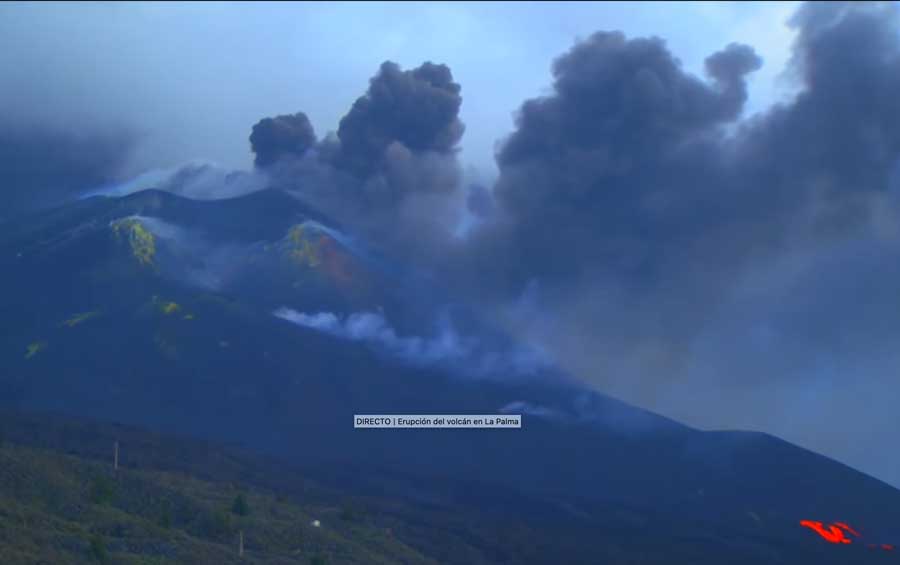
The active vents seen this evening producing mild ash emissions (image: Canarias TV live stream)
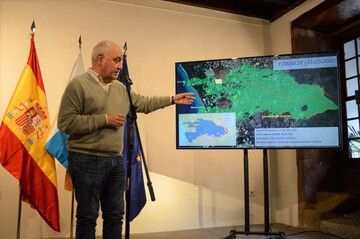
Showing the newest lava flow towards Las Manchas during this afternoon's press conference (image: La Palma Government)
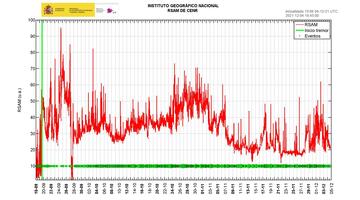
Volcanic tremor amplitude since start of eruption (image: IGN)
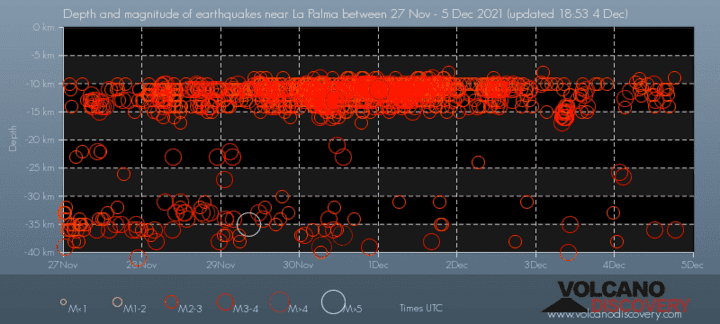
Time vs depth of quakes under La Palma during the past days
The technical Director of the Civil Protection's volcanic emergency plan (PEVOLCA), Miguel Ángel Morcuende explained in
the latest press conference about the status of the volcanic eruption, that the new lava flow at the southern margin of the flow field was advancing in southwesterly direction towards Camino La Majada, covering land that was left untouched between the previous lava flows labeled #3 and #11, but has long since been evacuated.
Initially fast-flowing, the new lava flow has slowed down by now, as it lost fluidity along its path.
Other lava flows, namely #7, 8 and 10 continue also be alimented, but less than during the past days. No lava is currently arriving at the sea deltas.
At the vents, activity has been much lower today, too. Lava fountaining ceased it seems, replaced by more intermittent and weaker strombolian activity. Ash emissions have been less vigorous and also discontinuous today, but still produced low plumes that reached approx. 2,000 m altitude and drifted in westerly directions over the Atlantic.
The lava flows from the new vent system that had been extremely active in the past days were practically inactive today.
Yesterday, a north-south oriented fissure with central subsidence but no visible activity nor signs of such in the recent past was detected at 100 meters distance south of the main cone.
Latest dataThe affected area by lava flows stands at estimated 1,146 hectares, with a maximum width of 3,350 meters. The size of the lava deltas remains unchanged at 48 hectares.
Ground deformation has partially reversed the inflation episode in the vicinity of the Jedey (LP03) station; this might be the result of today's lava flow effusion. The rest of the network shows no significant changes. Volcanic tremor has decreased compared to the past days and is now at similar intensity as 2-3 weeks ago, still significant and indicator that magma continues to flow to the surface.
Seismic activity has calmed down to some of the lowest values since the start of the crisis: During the past 24 hours, there were only 9 quakes of magnitudes 3.0 or above, the largest being a 3.4 event, and 21 small quakes between 2.0 and 3.0.
Despite the lower activity both at the surface and under as detected by seismic and deformation measurements, the gas emissions, in particular sulfur dioxide(SO2), remain high (no precise value given). This suggests that there is still a lot of magma available at depth.
New lava flow
Update Sat 04 Dec 2021 16:20
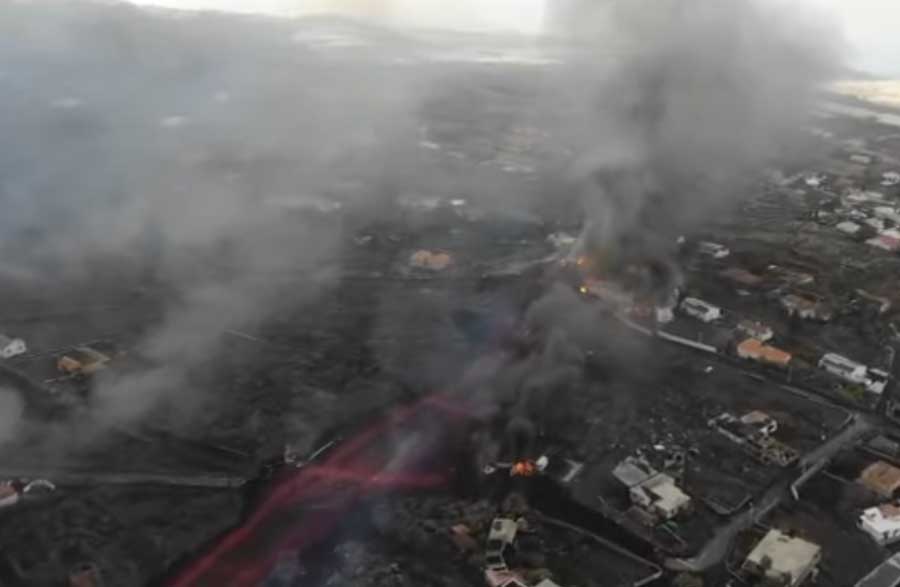
The new lava flow south of the existing flow field this afternoon (image: Municipality of El Paso / youtube)
As feared by the inflation signal in the past days, the relative calm at the volcano has come to an end and new magma arrived at the vents earlier, causing another overflow of lava.
Most notably new lava flow has started on the southern side of the eruption area to advance westwards through new land. It has already reached the Camino Real de Todoque and is descending parallel to Camino Aniceto and Camino La Majada roads.
On his way, more houses, plantations and roads were destroyed. The arrival of the lava flow in the Las Norias area is imminent.
Aerial video by the municipality of El Paso:
Update Fri 03 Dec 2021 15:35

Aerial view of the northern margin of the lava flow field as seen by the government surveillance drone this morning (3 Dec 21, 10.15 a.m.; source: opendatalapalma.es))
Increasing inflation, moderate volcanic tremor
Update Fri 03 Dec 2021 15:30
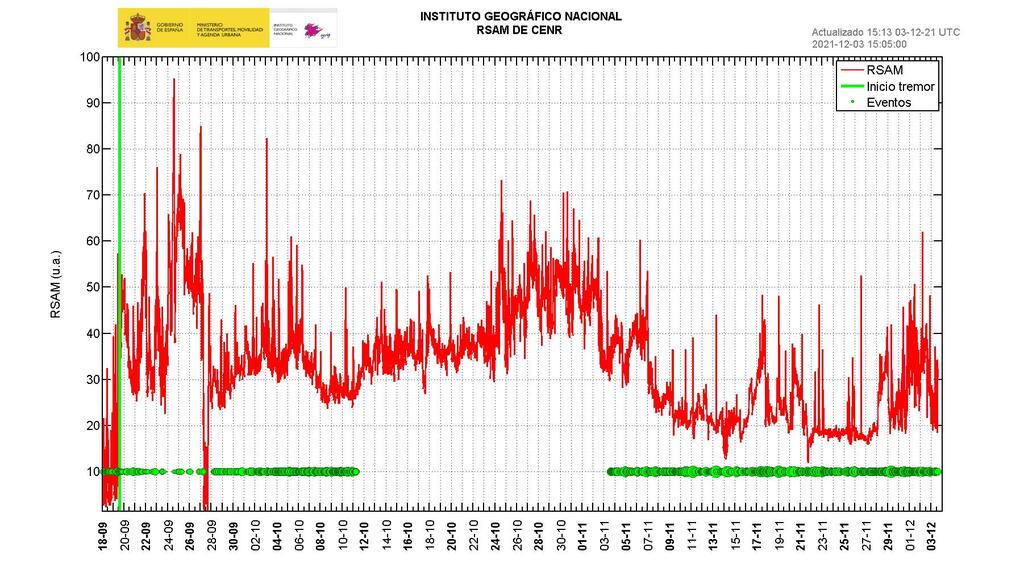
Current tremor amplitude past 7 days (IGN)
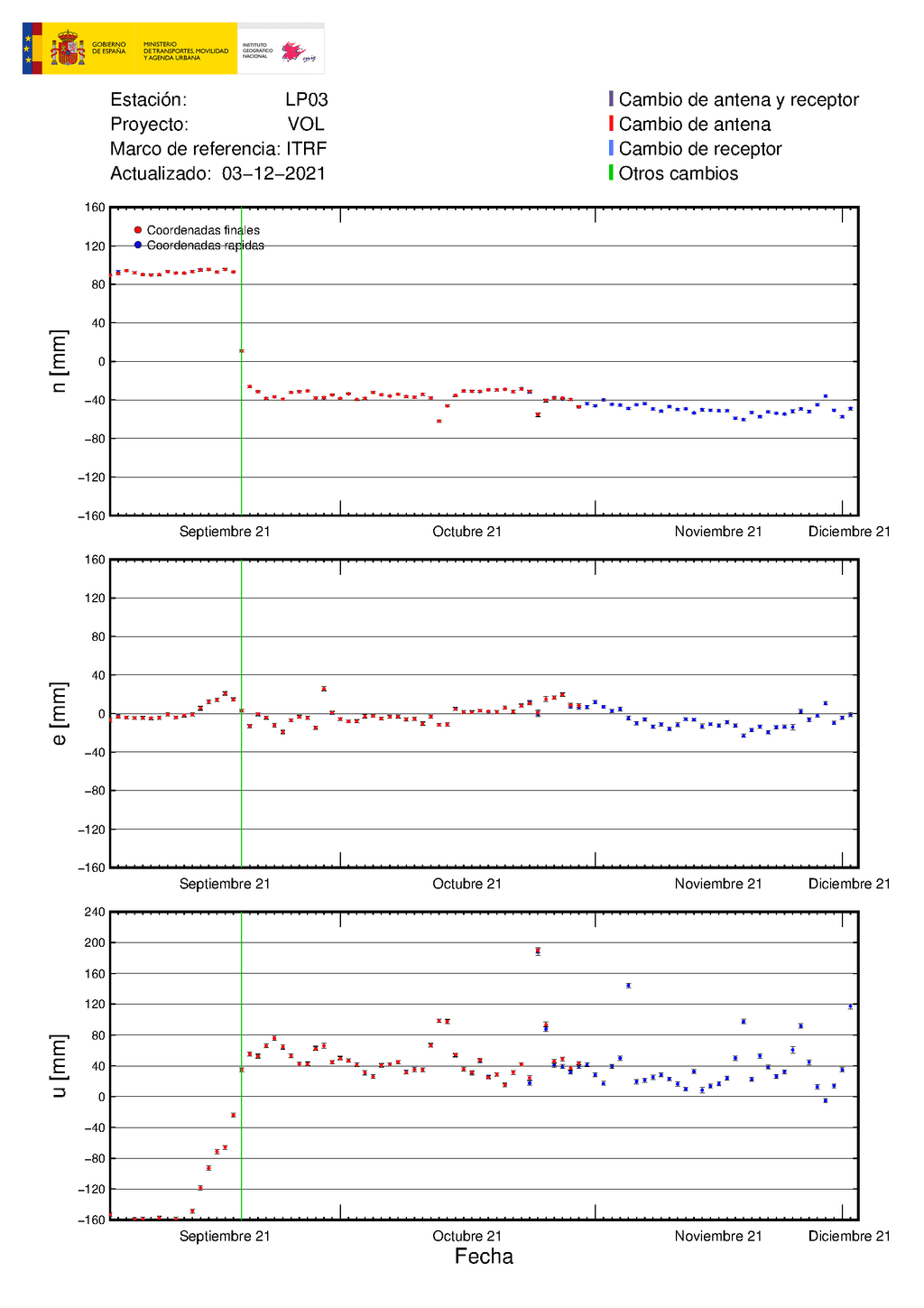
Ground deformation at LP03 station (image: IGN)

Seismic trace and spectrum TBT station (image: IGN)
Yesterday's trend seems to continue - less vigorous activity visible at the surface and less earthquakes today (only 24 quakes from magnitude 3.0 or above, the largest a 4.2 event in the past 24 hours), but at depth, a new surge of magma might be preparing itself. This is shown by increasing inflation.
Volcanic tremor remains at strongly fluctuating moderate levels.
Update Fri 03 Dec 2021 15:20
The drone video of the Municaplity of El Paso shows the activity of yesterday morning nicely:
La Palma volcano eruption update: activity drops for the moment, but new surge of magma likely to arrive in the near future
Thu, 2 Dec 2021, 16:51 16:51 PM | BY: T
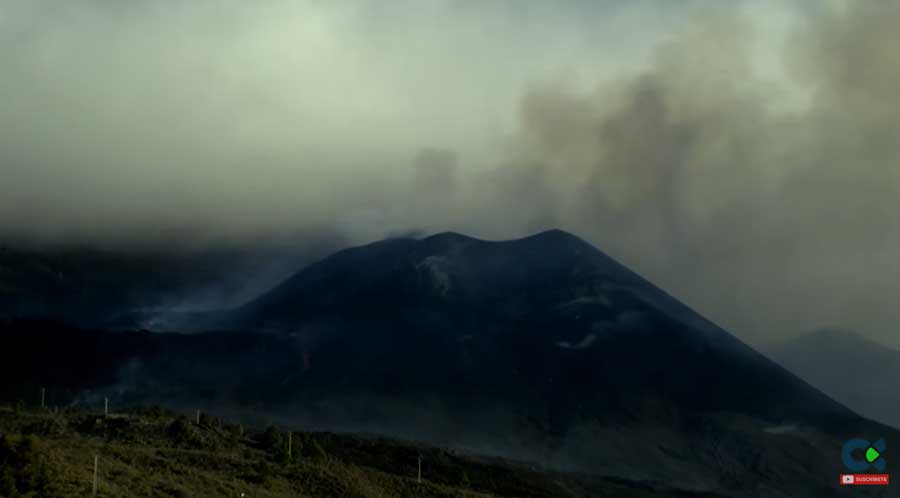
Weak activity at the vents on La Palma this evening, maybe the calm before the storm... (image: Canarias TV live stream)
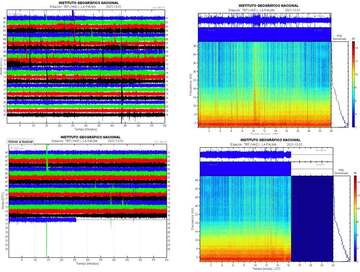
Current seismic signal LP01 station (image: IGN)
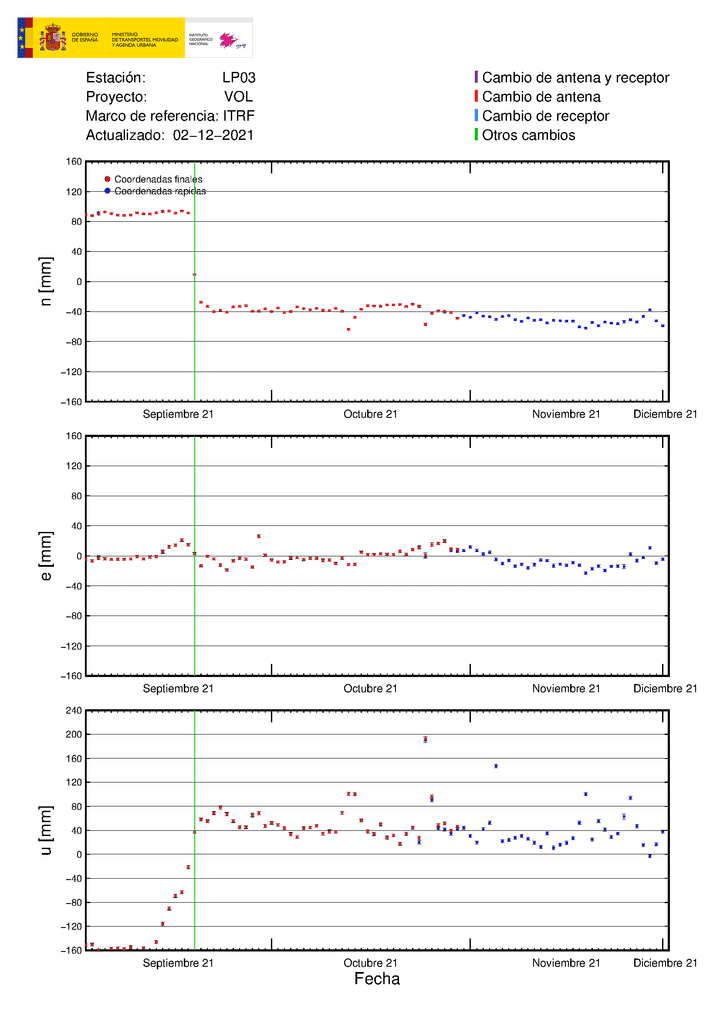
Ground deformation at LP03 station showing the new uplift (image: IGN)
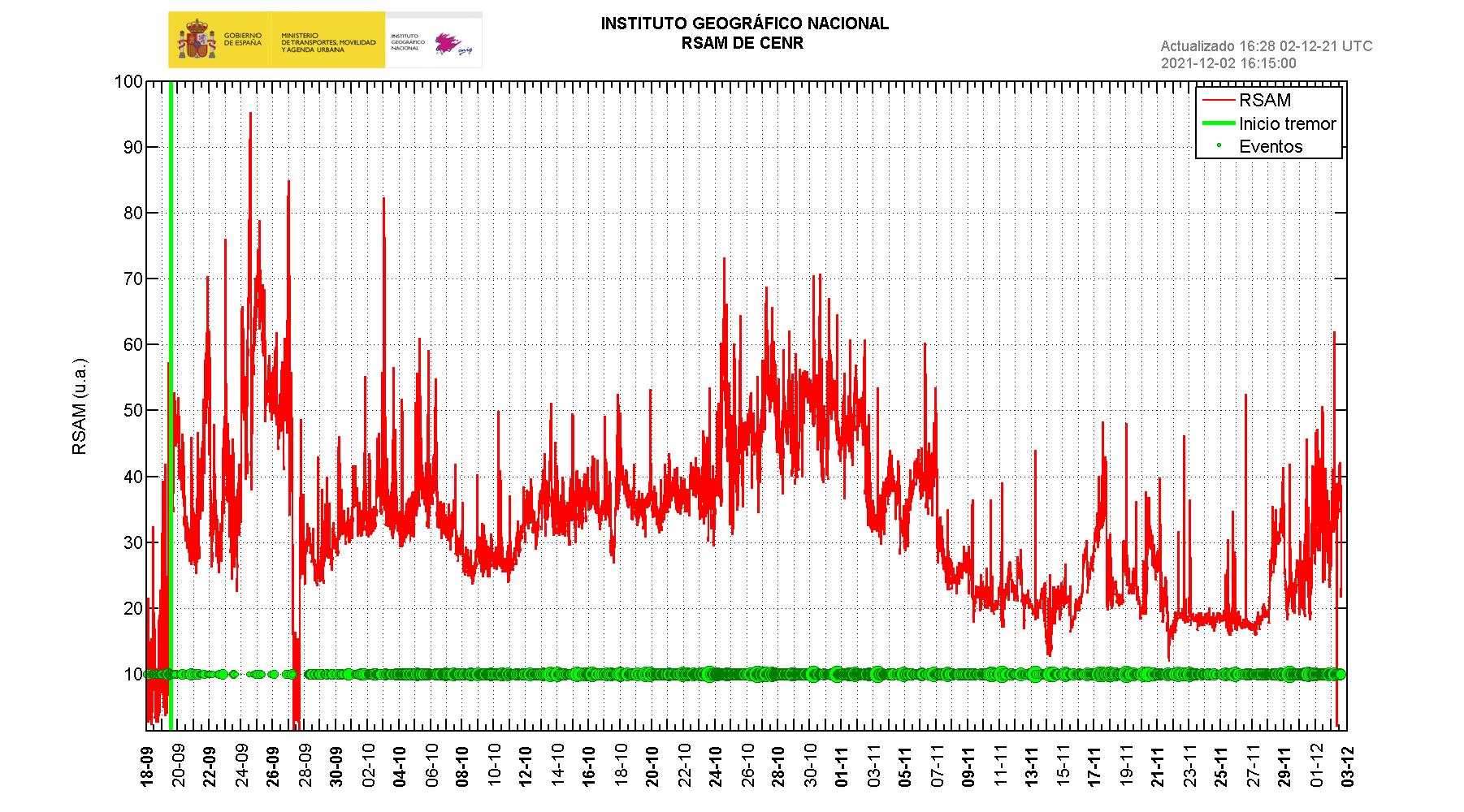
Current tremor amplitude since start of eruption (image: IGN)
After the surge of magma during the past days, the activity has now dropped again significantly, but there is a new signal of ground uplift, which suggests that a new batch of magma is on the rise and currently being stored and likely to come out as a new surge probably in the next days... There is certainly no sign of the eruption ending soon.
Even if it has been gradually decreasing today, the explosive and effusive activity from the new (as well, to a lesser extent from the old) vents are continuing. Volcanic tremor remains comparably high and has strong temporary peaks, indicating magma flux remains significant.
This morning, ash plumes rose to 1,900 m and drifted into southerly and southwesterly directions over the ocean (leaving the airport free). Lava flows continued to be active near the new vents and along the path towards La Laguna. Some of the older lava tubes also remain active with smaller breakouts mostly in the central area of the flow field, but no or very little lava is currently reaching the ocean entries.
The intense lava fountaining has already created a new cone adjacent and now morphologically likely soon merging with the main cone. Several lava flows descended from the vent area over a steep slope into the area of Tacande and the northern margin of the existing lava flow field.
The new lava flow was labelled #12 and is in parts parallel to #8 and downslope joins or overlies it. On its way, ti covered new areas and destroyed additional buildings, unfortunately. As of yesterday evening, its active fronts were located about 800 meters from La Laguna.
Latest dataThe area covered by lava flows stands at 11.5 square kilometers and has a maximum width of 3,350 meters. It is estimated that 1,548 buildings have been destroyed according to counts from the government, although satellite data suggest a much higher count of 2,860 buildings destroyed or damaged so far.
Seismicity remains intense, although has decreased after peaking during the day before yesterday and yesterday, when nearly 400 quakes were recorded on each day. During the past 24 hours, there were “only” about 150 quakes of magnitudes above 2. The strongest quake was a widely felt
magnitude 4.2 quake at 11 km depth this morning at 5.14 a.m.
The locations of the earthquakes remain the same, clustered in two layers, one between 30-40 km depth and the other one at shallow depths between 10-15 km, both under the central part of the Cumbre Vieja volcano. It is thought that these are the main storage areas of the magma feeding the eruption.
Latest map of lava flows
Update Thu 02 Dec 2021 16:43
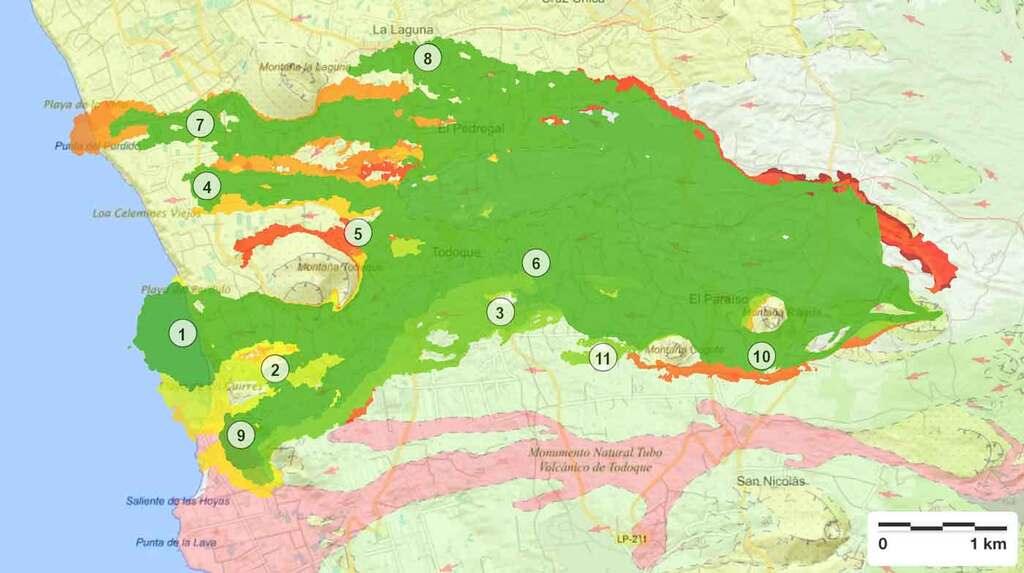
Latest map of the lava flows (image: info.igme.es)
The most recent map of the lava flows compiled by the Spanish Geographic Institute now shows the new lava flows from the new vents at the northeastern base of the existing cone.
Tall lava fountains
Update Thu 02 Dec 2021 12:58

Lava fountain from the new vent at La Palma last evening (image: INVOLCAN)
Last night, activity increased and to sustained lava fountains from the main vent of the new vent system on the northeastern side of the cone:
This activity continued more or less all night and today so far. Here's a video INVOLCAN took this morning:
La Palma volcano eruption update: lava flow activity decreases while earthquakes reach record numbers
Wed, 1 Dec 2021, 10:04 10:04 AM | BY: T
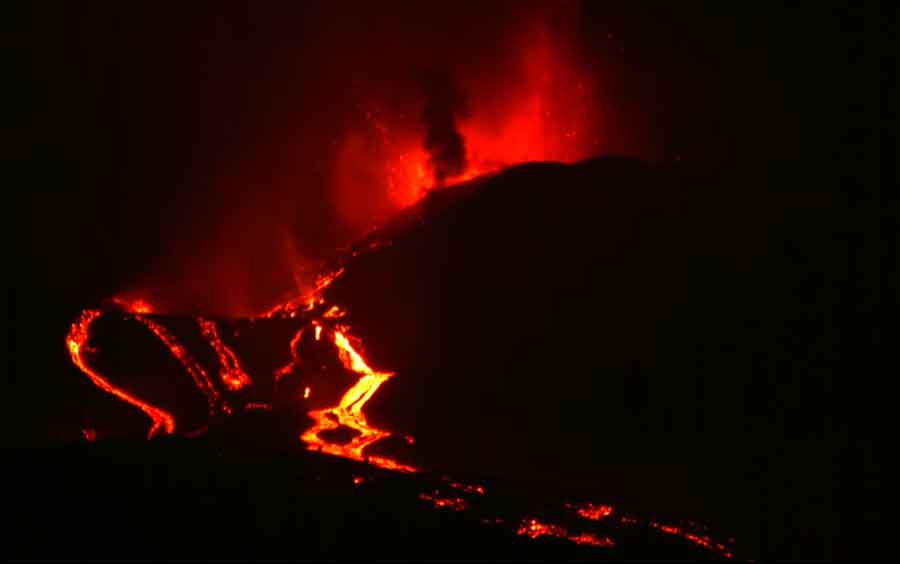
Lava emission at the vents early today (image: Canarias TV live stream)
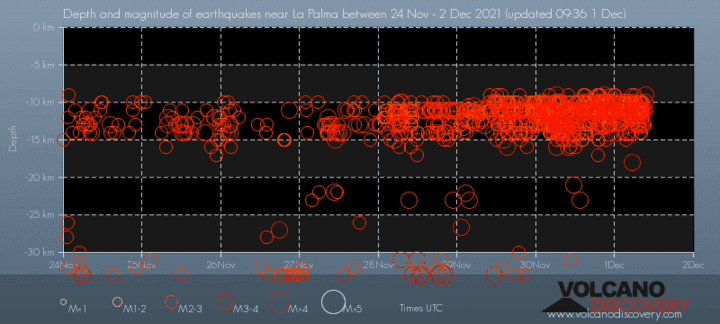
Quakes vs depth under La Palma during the past 7 days, showing the latest increase
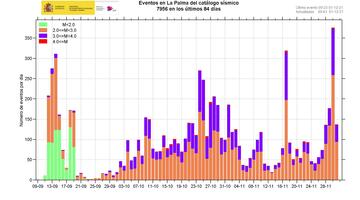
Current tremor amplitude (image: IGN)
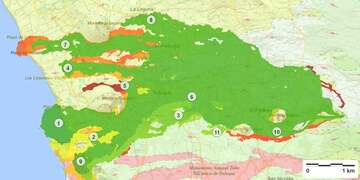
Latest lava flow map (image: IGME)
Seismic activity reached a record number of almost 400 quakes of magnitudes above 2 during a 24 hour window yesterday. Volcanic tremor has increased and continues to fluctuate strongly.
While internal activity is high, the visible activity has decreased a bit since yesterday. According to official statement, there are now "moments" with no (or almost no) activity at the vents. These alternate with phases of frequent and loud explosions, sometimes accompanied by short-lived lava fountains and ash emissions.
The lava flows that had been spectacularly active in the past days continue to be visible near the vents, but were much less so in the past 12 hours. It might be that some of this apparent decrease is due to the fact that most lava is flowing inside the tunnels, but on the other hand, there has been very little advance at the fronts, most of which seem to be cooling now. According to the latest data, the area covered by lava flows stands at 1,134 hectares, out of which 43.46 Ha are at the southern and 5.05 Ha at the northern lava delta. The lava flow field has a maximum with of 3,350 meters.
As seen multiple times in the past weeks, the apparent (at least relative) calm of visible activity can change very quickly, and is likely no indication that the eruption is close to an end.
Activity remains intense
Update Tue 30 Nov 2021 15:49
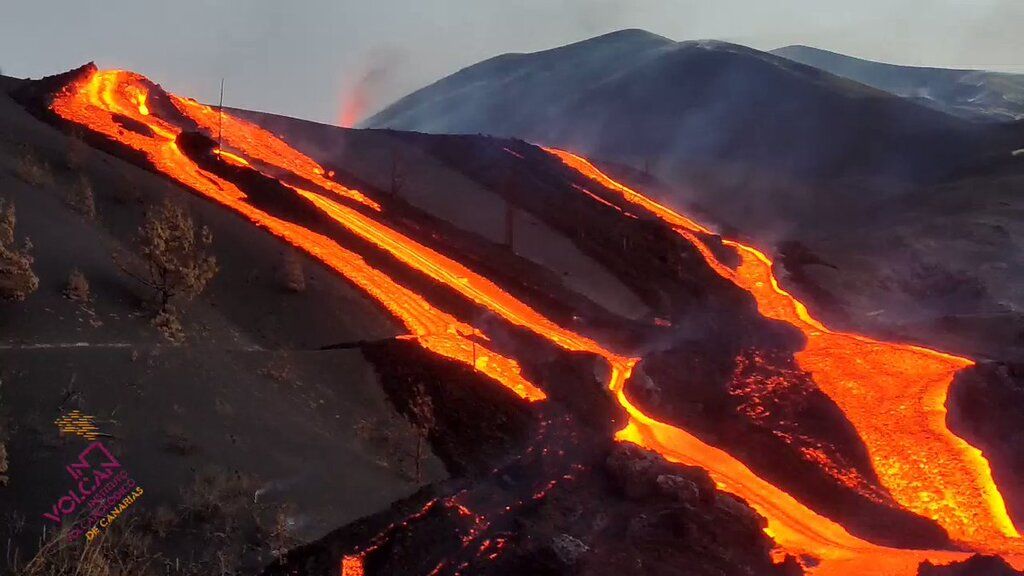
Large lava flows at La Palma yesterday evening (image: INVOLCAN)
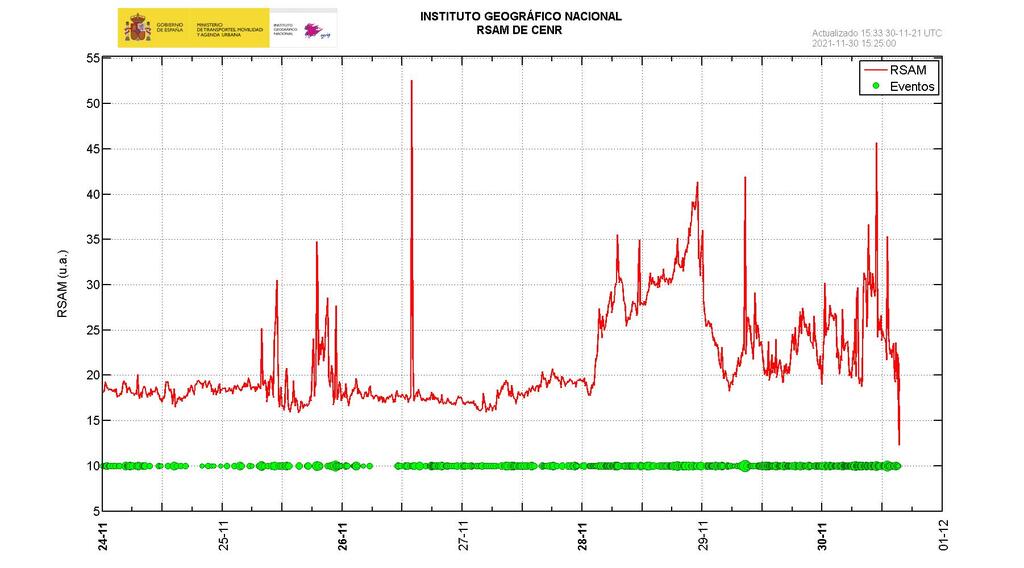
Volcanic tremor amplitude past 7 days (image: IGN)
Abundant lava effusion as well as mild fountaining and ash emissions from the new vents around the northern feet of the cone continue at similar levels as yesterday.
Volcanic tremor fluctuates strongly around moderate levels, while seismic activity is picking up and overall deflation of the ground continues, which points to rapid discharge of stored magma. Lava flows advanced into so-far untouched parts of the industrial area of Los Llanos.
Some impressions from today's and yesterday evening's activity:
Yesterday evening's lava flows were truly impressive:
Lava flows approach La Laguna
Update Tue 30 Nov 2021 07:05
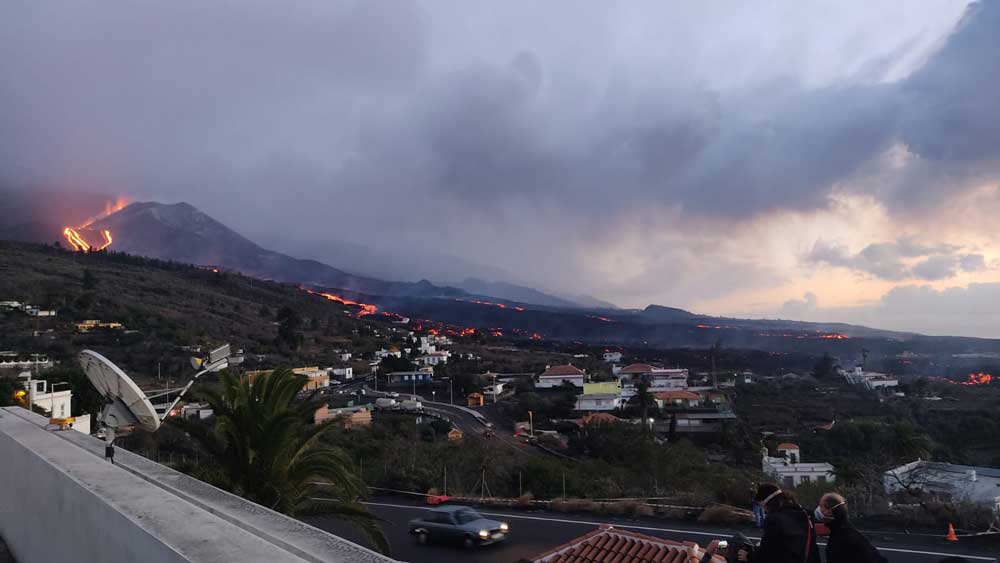
Lava flows near Tajuya and approaching La Laguna on the evening of 29 Nov 2021 (image: Evelyne Pradal)
The attached picture shows the lava flows seen from the church viewing spot yesterday afternoon at 5 p.m. The thickness of the lava flows, at least 10 meters, is quite impressive.
Lava overflowed tube system (video)
Update Tue 30 Nov 2021 03:30
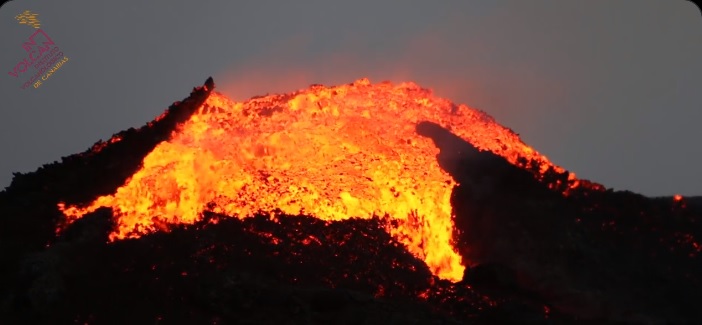
Lava overflowed onto the outer slopes of the lava tube (image: @involcan/twitter)
The intense effusive activity continues from the northern vents of the cone opened yesterday.
Lava flows quickly reached north of the existing flow field and continue to advance further at high discharge rate.
The new lava flows are also going into the newly formed lava tube system as can be seen in the attached video where lava has filled one of the lava tubes in the Tacande area and overflowed onto the outer slopes.
Update Mon 29 Nov 2021 19:29
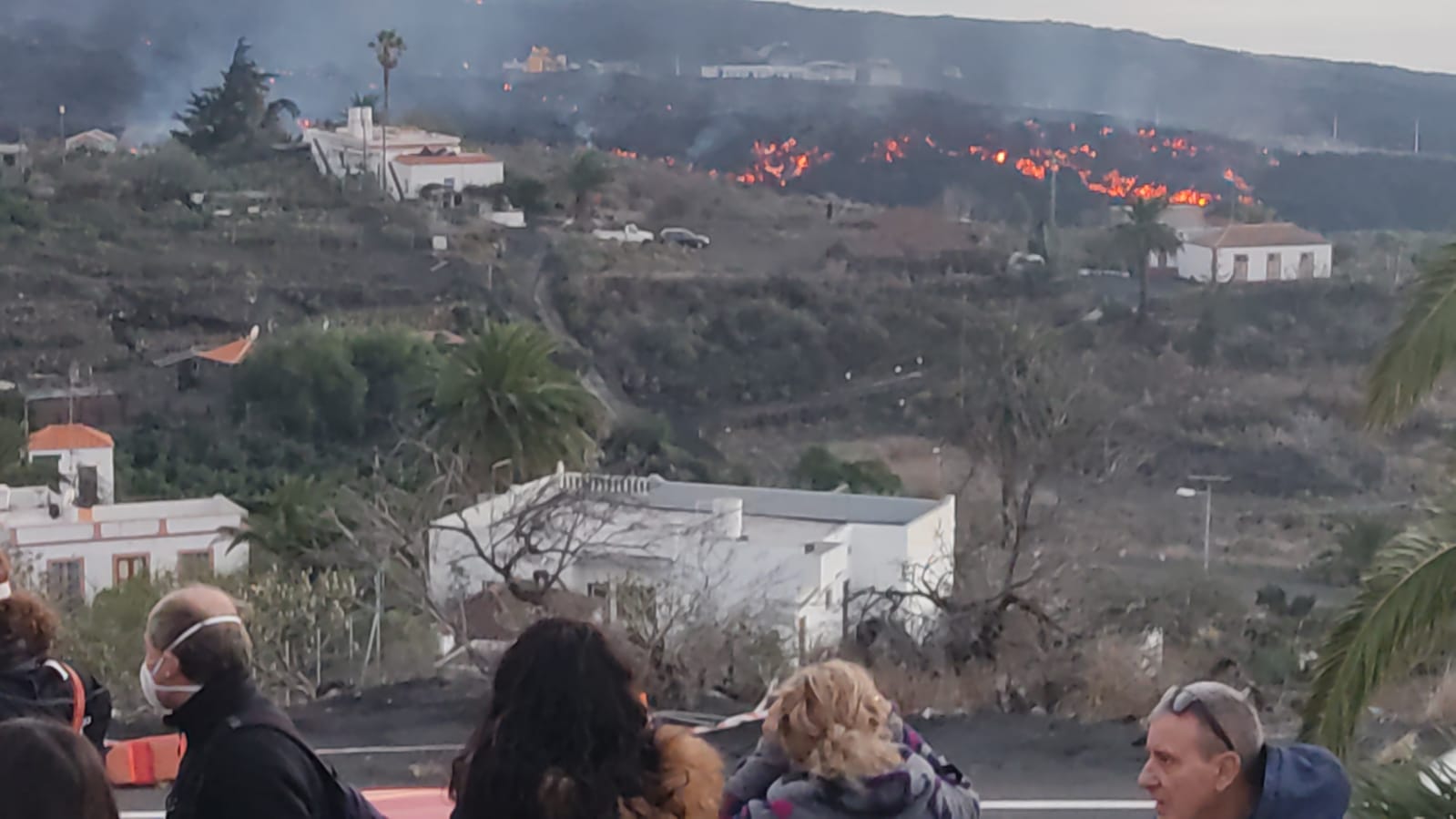
Lava flows near the main road this evening (image: Evelyne Pradal)
The attached photo from this afternoon shows how close the lava flows have come to the LP3-LP2 main road junction in Tajuya.
Video of lava fountaining at the fissure
Update Mon 29 Nov 2021 17:49
Lava fountains continued today from the main vent of the new fissure that opened yesterday along the northern base of the cone:
Also interesting this morning's drone overflight:
Update Mon 29 Nov 2021 13:41

Aerial view of the new lava flow this morning (image: La Palma government)
This morning's aerial imagery taken by the government surveillance drone showing the main lava flow from the new vents traveling along the northern margin of the flow field, just few hundred meters from the roundabout junction of LP-2 and LP-3 near El Paso Abajo.
Update Mon 29 Nov 2021 13:34
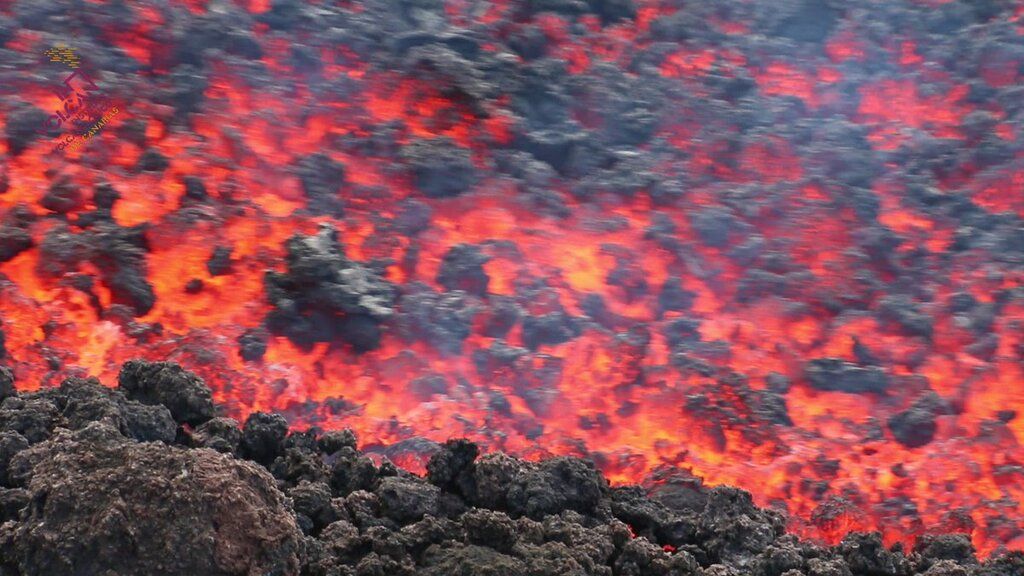
Close-up of an active lava flow at La Palma this morning (image: INVOLCAN / twitter)
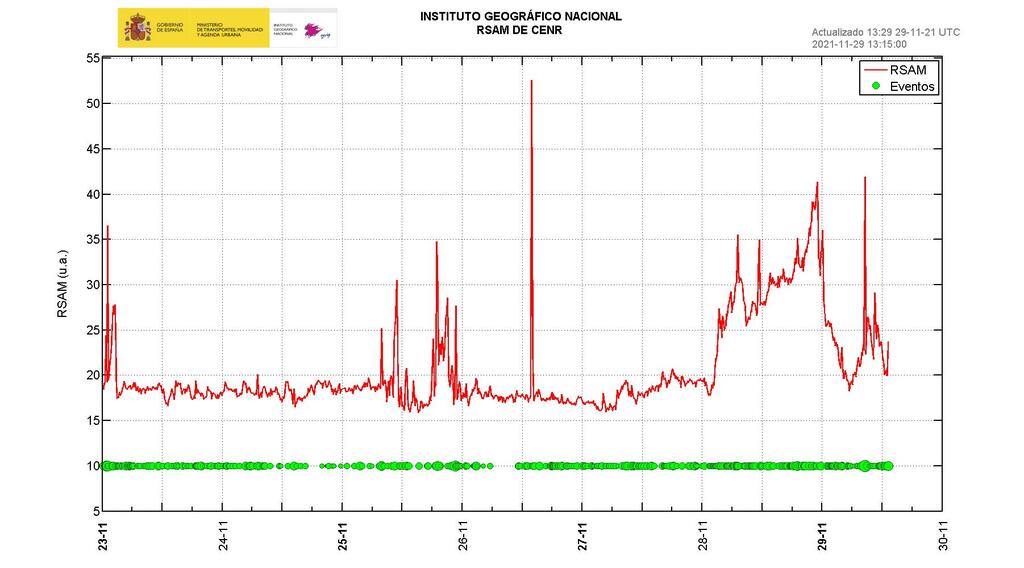
Current tremor amplitude past 7 days (IGN)
The eruption continues at elevated levels with low lava fountaining and abundant lava flow emission from the new vents that opened yesterday morning around the northern base of the cone. Associated ash emissions have been rising to 1,400 m altitude and drifting south-southwest over the sea.
The new lava flows follow a route around the northwestern side of the cone and have been advancing quickly north of the existing flow field, on their path invading new land and destroying additional structures. So far, 2,695 building have fallen victim to the lava flows since the start of the eruption.
The most northerly of the active flows has come dangerously close to the main LP-3 road junction in Tajuya, which is the principal artery for traffic to connect the Aridane Valley with El Paso.
Volcanic tremor has dropped from its steep peak, but remains elevated when compared to the situation before the new vents opened, likely in tandem with ongoing high lava effusion rates.
Near Tacande, the lava flows are advancing at 1 m per second, seen in the following videos posted by INVOLCAN this morning:
Sharp spike in volcanic tremor amplitude
Update Mon 29 Nov 2021 09:05
A strong spike in volcanic tremor amplitude has appeared, perhaps in response to the magnitude 4.8 quake half an hour ago. After the elevated activity yesterday, the tremor signal dropped again over night, but it remains to be seen what happens today.
Deformation continued its path of deflation, likely because a of magma was erupted through the new vent system, more than was added from deeper reservoirs.
Earthquakes pick up again - unusual magnitude 4.8 quake under southern tip of island
Update Mon 29 Nov 2021 09:00
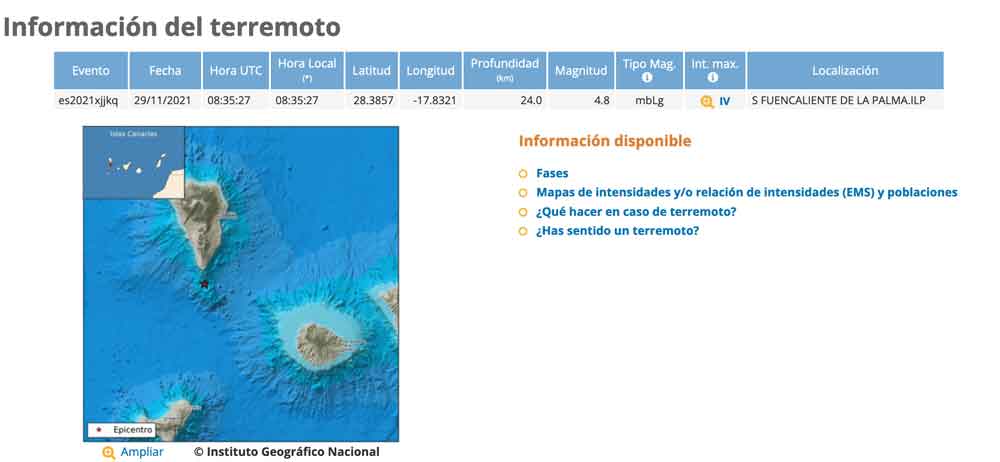
Preliminary location of this morning's magnitude 4.8 quake under La Palma (image: IGN)
After a few relatively calm days, earthquake activity has picked up again since yesterday.
In the past 24 hours, there were 2 quakes of magnitudes 4.3 and 4.8 along with 42 quakes between 3.0 and 4.0. The
magnitude 4.8 quake occurred a short time ago, at 8.35 a.m.
If the preliminary data are correct, it is quite unusual for both its depth at intermediate 24 km (i.e. in between the prevalent shallow layer around 10-15 and the deeper layer at 30-40 km, where most quakes so far have been clustered) and its horizontal location, which is indicated as under the southern submarine extension of the Cumbre Vieja ridge are a novelty for the location quakes of that magnitude.
New lava flows quickly reach several kilometers length
Update Sun 28 Nov 2021 18:55

View of the eruption this evening (image: Evelyne Pradal)
The image shows the eruption from the new vents this evening as seen by our group on the La Palma volcano special tour currently on location. The new lava flow from the fissure on the northern side of the cone have already reached a length of a few kilometers and their fronts have reached the area of La Laguna as well as Dos Pinos.
Watch the latest aerial drone videos of the El Paso government:
Largest eruption in 500 years
Update Sun 28 Nov 2021 17:07
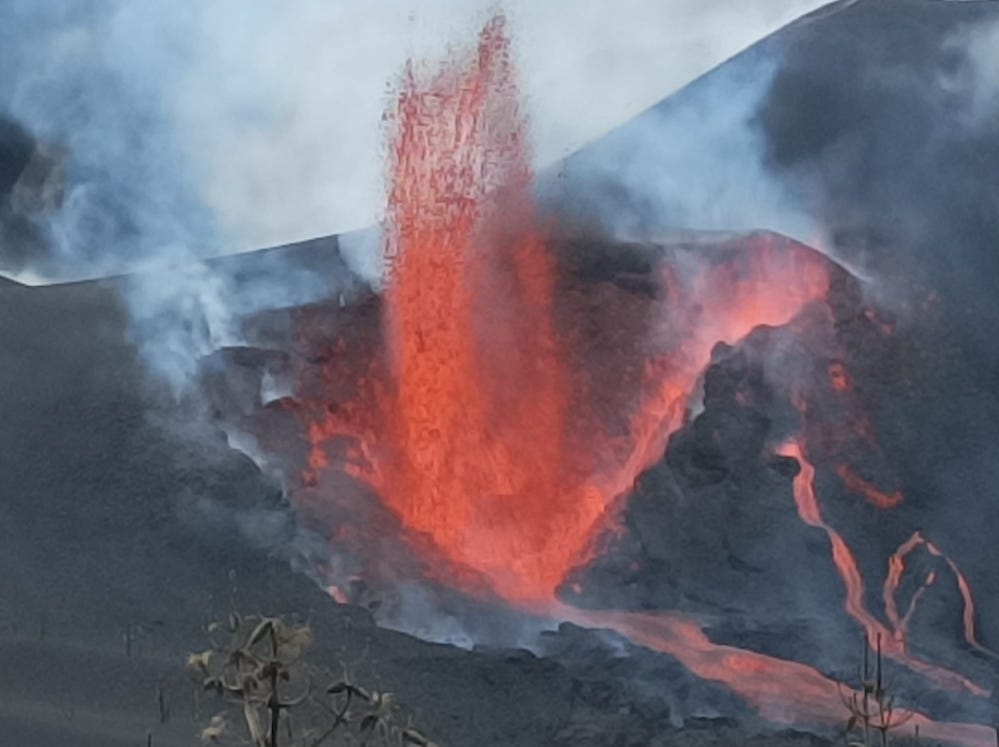
Lava fountain at the new fissure on the northern base of the cone today (image: El Time @ElTimeLaPalma / twitter)
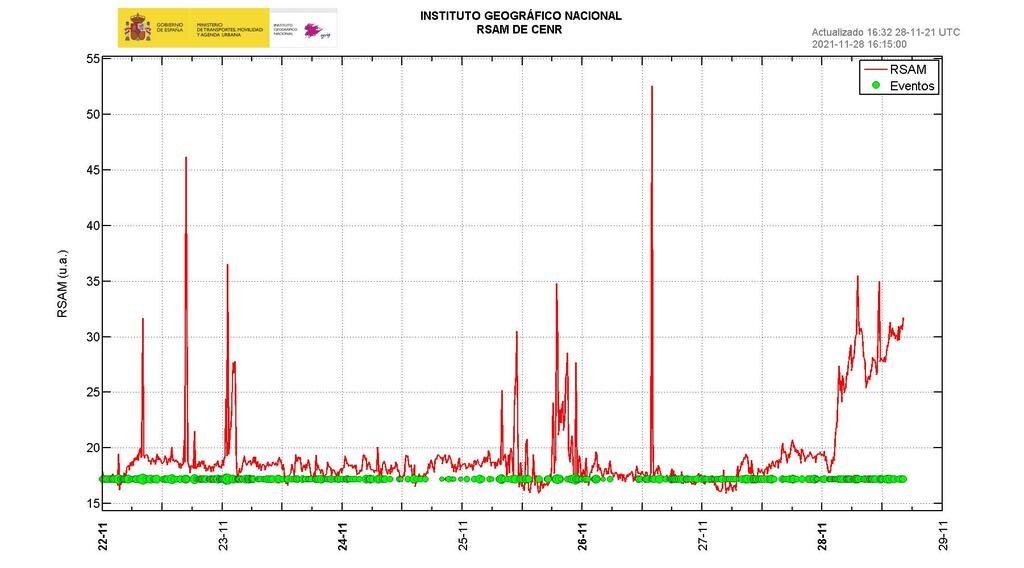
Current tremor amplitude past 7 days (IGN)
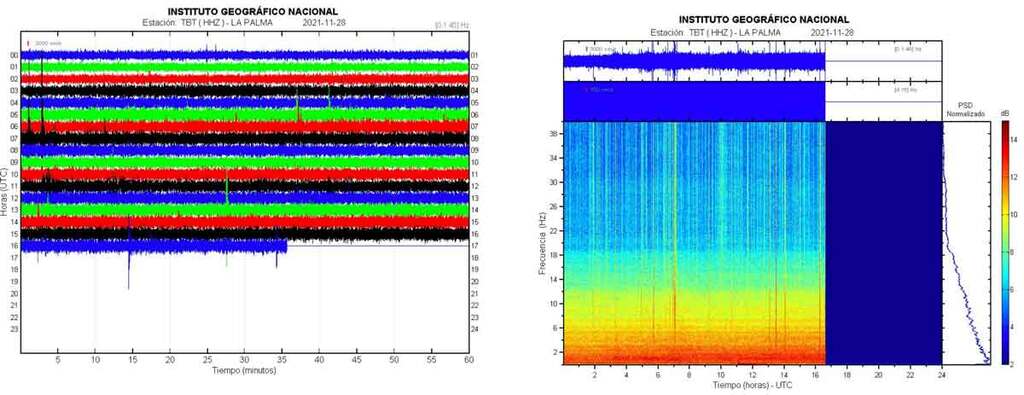
Current seismic signal at La Palma's TBT station (image: IGN)
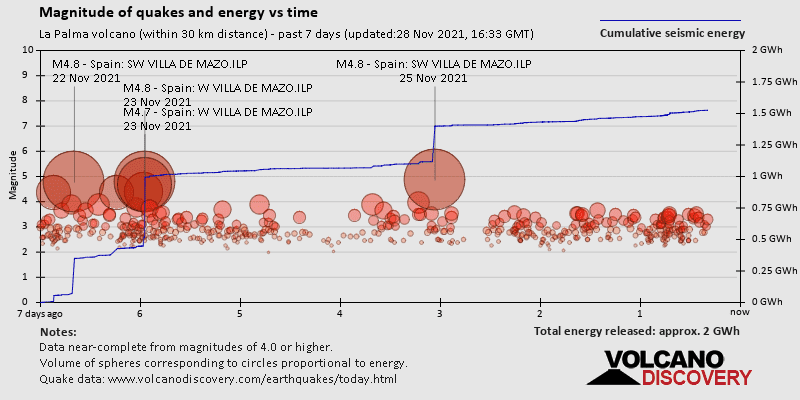
Quakes and released energy during the past 7 days
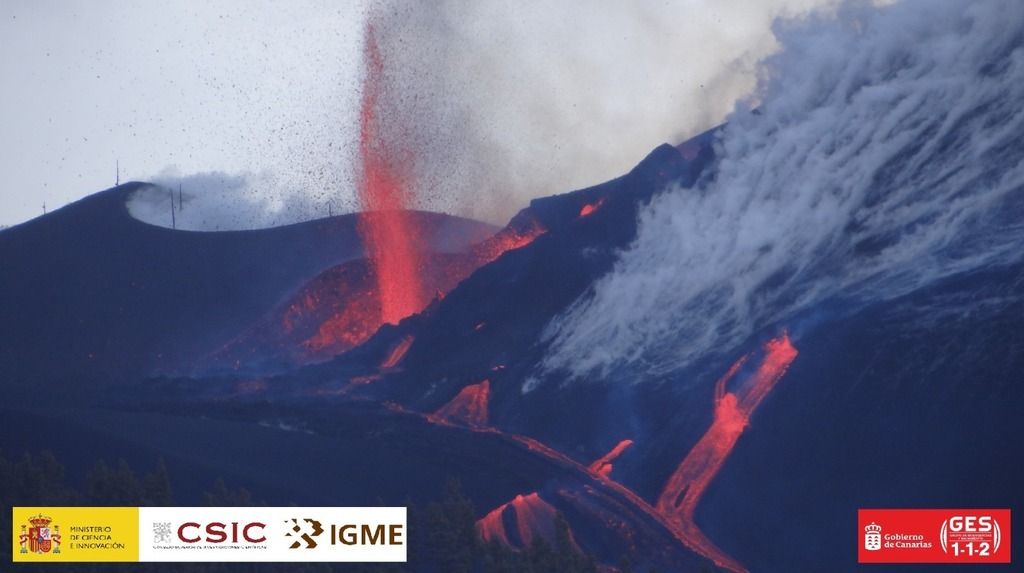
The new vents on the flank of the cone seen by drone (image: IGN / Government of La Palma)
The lava flows from the new vents have quickly crossed the Tacande road and are enlarging the northern margin of the flow field, covering new so-far untouched land in that part. Updated data on the extent of lava flows and maps can be expected tomorrow.
The ongoing eruption is already counting as the largest on La Palma Island in over 500 years. It has likely overtaken the 1585 eruption at Tahuya as the largest by volume eruption on the island in recorded history. The latter erupted approx. 300 million cubic meters (or 0.3 cu km) of lava, while the exact volume of the current and still ongoing eruption is estimated to be at about this value already.
Along with the new vents allowing magma to quickly rise through a new (and compared to the older vents likely "easier") path, volcanic tremor has jumped up significantly this morning.
At the same time, the inflation from the past days has been neutralized by an almost equal deflation signal - this suggests that the extra amount of magma stored recently has been erupted during the ongoing surge of activity that began this morning. How long it will last will be shown in the near future.
The opening of the vents was not accompanied by significantly changed seismic activity, which indicates that the magma needed little energy to break through the ground at nearby locations as before. Earthquakes have increased marginally in numbers, but not in energy during the past 24 hours. The National Geographic Institute recorded 91 events of magnitudes up to 3.5.
The activity at the old and new vents produces dense ash plumes, rising to 1,600 m above sea level and drifting southwest over the Atlantic Ocean (and sparing the airport on the east coast).
As to the other lava flows, activity continues to feed them as well: according to the latest official summary of the situation, the flows labelled #7, #4-5 and #1-9, as well as #10, which has merged with #11 further south, but stopped its advance. Various active fronts are fed by the tube system, most notably in the area near Laguna Hill.
The total area covered by lava flows, including the lava deltas, stands at 1,151 hectares.
Update Sun 28 Nov 2021 16:34
La Palma volcano eruption update: new vents open at northeastern side of the cone, generating lava fountains and new lava flows
Sun, 28 Nov 2021, 16:31 16:31 PM | BY: T
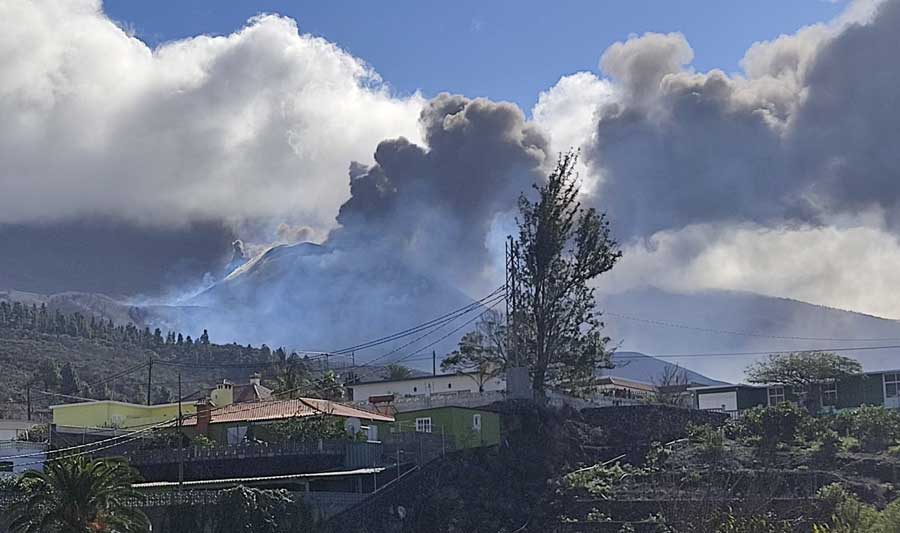
View of the cone this morning with ash plumes and steam rising from the new vents (image: Evelyne Pradal)
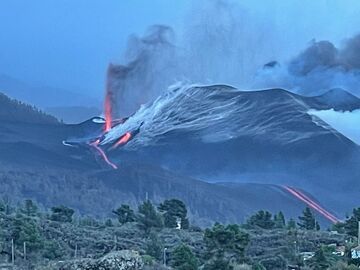
View of the lava fountains and flows at dawn (image: ALex García / FRANCISCA GONZALEZ @FRANCESCAGONZ37 / twitter)
Several new vents opened this morning at the northern and northeastern base of the main cone, producing lava fountains and emitting new lava flows that travel around the northern side of the cone.
This comes as a result of a new surge of magma that announced itself as underway by the recently observed inflation during yesterday and the previous day. Instead of erupting through the existing vents at the cone, like on Thursday, the magma chose to create new vents nearby - likely, the older conduits at the cone have become too high and too "difficult" to reach compared to creating new fissures at the base of the cone.
First visit to our site? If you havn't done it yet,
download the Volcanoes & Earthquakes app to get one of the fastest volcano news online:
Android |
IOS






































































